
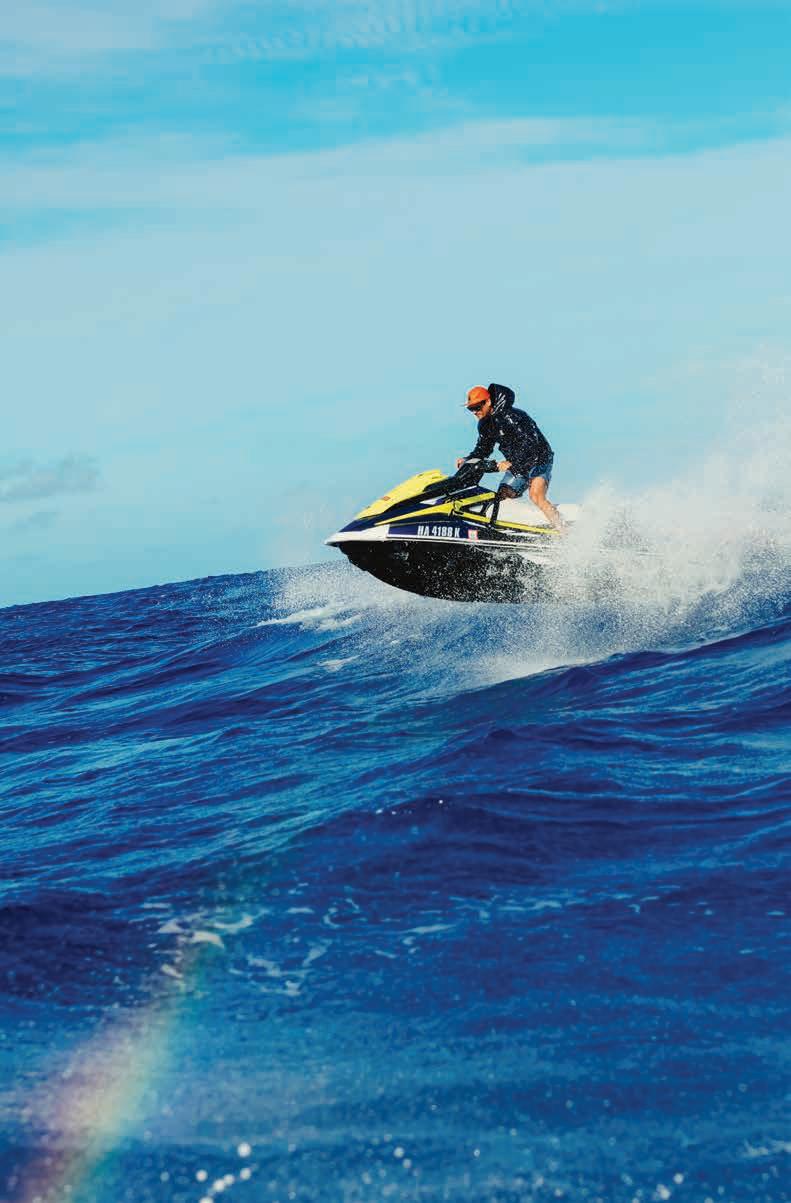

TABLE OF CONTENTS INSIGHT 10 HL1 MARKET REPORT CRAFT 28 THINGS OF BEAUTY 40 AN UNCOMMON ART DISCOVER 54 A PERFECT DAY 72 THE CHANNEL CROSSER 80 STRONGER TOGETHER 90 GREENER PASTURES COLLECTION 102 3
Matthew Beall
owner , principal broker
Kahea Zietz
co - owner , vice president
Anthony Arnold creative director
HL1 DIRECTORS
Carrie Nicholson RB
Neal Norman RB
Josh Jerman RB
Dave Richardson RB
Erik Hinshaw RB
Noel Shaw RB
HL1 MEMBERS
Steve Hurwitz RB
Tiffany Spencer RS
Beth Thoma Robinson RB
Julianna Garris RB
Robert Chancer RB
Ben Welborn RB
EDITORIAL PARTNERS
Jason Cutinella CEO & Publisher, NMG Network
Joe V. Bock Partner & General Manager, Hawai‘i
Lauren McNally Editorial Director
Taylor Niimoto Managing Designer
Eleazar Herradura Designer
Alejandro Moxey Senior Director, Sales
Sabrine Rivera Operations Director
MASTHEAD
4

DEREUSARCHITECTS.COM | 208.885.6222 SUN VALLEY | HAWAI’I | MAUI We leverage the relationship between place and building to create lasting memories for future generations. Nature, craft, and design - luxury defined.
Photographer: Joe Fletcher
HL1 began with a list of client’s names written on a whiteboard in our thenheadquarters in Hanalei.
What started as a relatively informal clientdiscovery process has since evolved into a journey of inquiry. Once we started asking questions and adjusting our representation based on the answers, our curiosity only deepened.
Regardless of our clients’ backgrounds or demographic profiles, or their varying degrees of wealth, the proverbial Venn diagram of their values, interests, hobbies, lifestyles, personalities, and even their media-consumption habits has revealed some powerfully distinct intersections.
It’s those intersections that led us to publishing HL1 Magazine.
Of course, no single edition could cover the full breadth of the ever-changing zeitgeist of our clients—though judging by the sheer thickness of some of our previous editions, we’ve certainly tried—but we can offer glimpses of insight into the essence of these rich intersections.
Now, nearly a decade later and in our seventh edition of HL1, it is with heavy hearts and hopes for a better future that those interests include shining a light on the Hawai‘i Community Foundation’s pivotal role in supporting ongoing relief and recovery after the devastating fires on Maui. In this issue’s Market Report, which has been appropriately truncated, we discuss the reality and impact of Hawai‘i’s collective attention being nearly completely occupied by recovery efforts and the ongoing impacts of the fires.
For those missing our historical infographics and more comprehensive high-end market data, rest
assured that we have that information—perhaps too much of it—at our fingertips. But in the interest of the half-life of this edition, we’ve opted to provide high-level insights into the current markets across the island chain—both in the context of the postpandemic market swings as well as the historic tragedy of the fires.
In such a time of reflection, we also take a moment to appreciate “Things of Beauty,” an intimate look into the personal collection of fine art consultant and curator Kelly Sueda on page 28. We also examine the radical legacy of architect Alfred Preis, whose artistry and visionary influence can be felt across Hawai‘i’s built environment. And to keep the inspiration and intrigue of real estate voyeurism alive, find a primer on the rural charms of Waimea on page 90, and be on the lookout in future issues for vignettes of other enchanting enclaves across the islands.
Perhaps more from a place of much-needed selfcare than escapism, we also bring you a photo essay shot over the course of a day on the north shore of O‘ahu, offering a glimpse of some of the customized experiences that await from sunrise to nightfall during a vacation rental stay.
Finally, in the spirit of moving forward, we asked rising star Jack Ho to recount the journey that led him to crossing the Ka‘iwi Channel at the 2023 Moloka‘i 2 O‘ahu race. Now, more than ever, we’re inspired by his determination, courage, and faith in what lies ahead.
Enjoy,
 Matthew G. Beall CEO, Hawai‘i Life
Matthew G. Beall CEO, Hawai‘i Life
6
WELCOME / LETTER


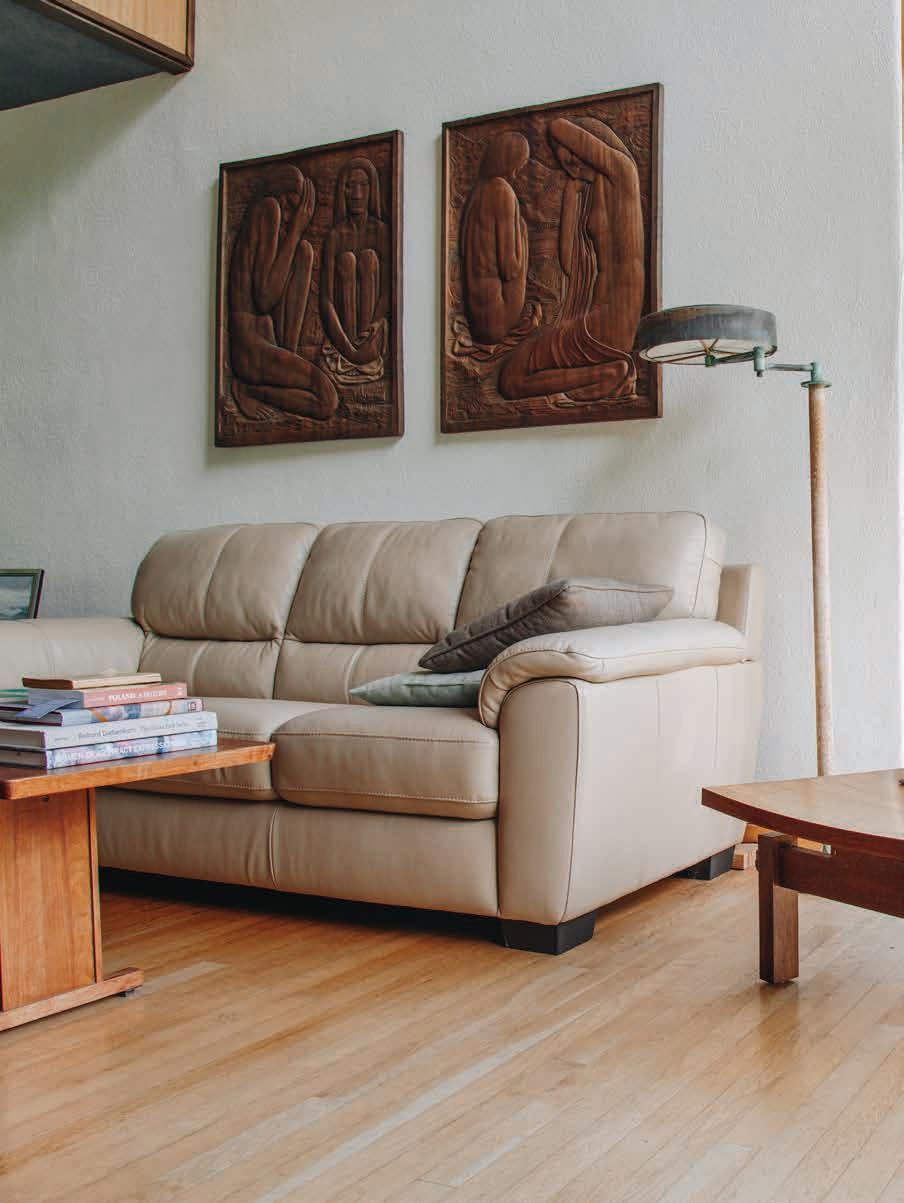
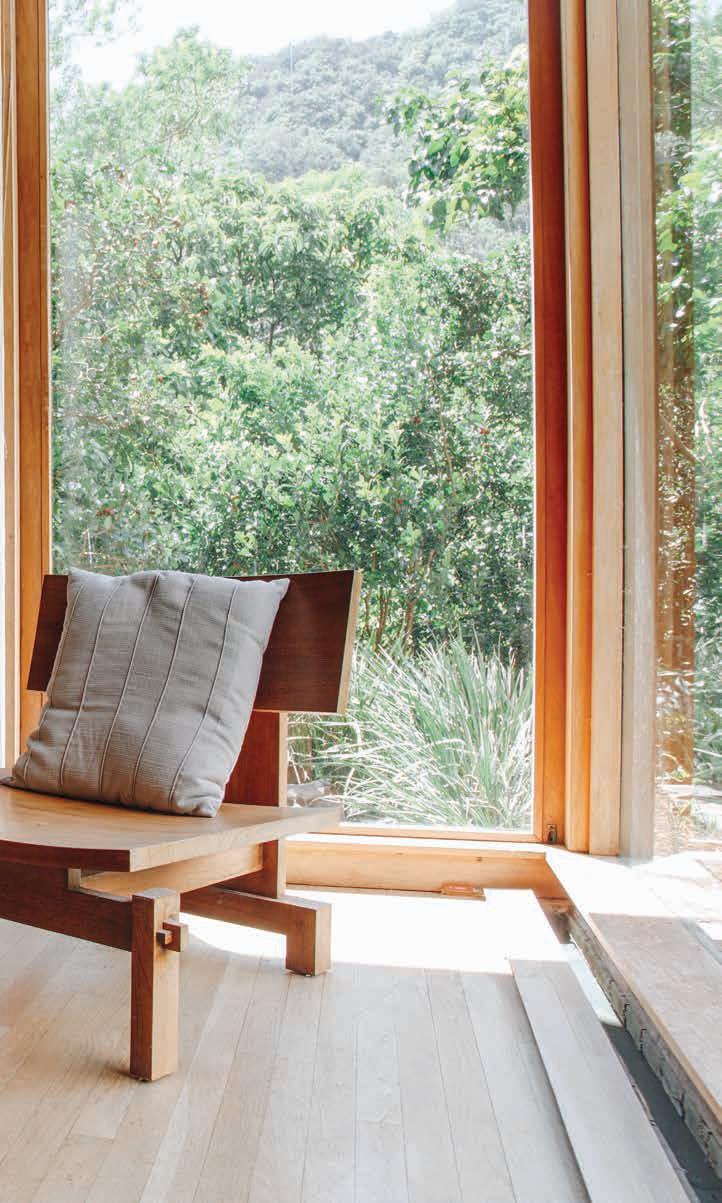
INSIGHT 9
HAWAI‘I LIFE ONE LUXURY MARKET REPORT
RESEARCH & WRITING BY MATT
BEALL
Sales and trends in Hawai‘i’s high-end real estate market.
2023
10
In March of this year, I gave a keynote address at a conference in Portland, Oregon, hosted by a creative agency that serves real estate, proptech, and fintech companies. The focus of my talk was how real estate marketing, especially in social media, is far too often devoid of the social, cultural, economic, and political contexts in which we are immersed. I argued that the pursuit of “personal brands” actually does more harm than good, or at least harm that’s difficult to measure.
I’m having to take some of my own medicine now in the wake of such extraordinary disasters on Maui. Last year, in the summary of our 2022 Midyear Hawai‘i Luxury Market Report, I wrote: “One thing we can predict with near-pinpoint accuracy is that there will likely be another seemingly unpredictable event, whether worldwide or localized, which will radically impact the luxury real estate market and skew any sense of normality. It’s just a matter of when.” If only that prediction didn’t come true. It’s hard, if not perverse, to write about luxury
real estate in the aftermath of the Maui fires, and the systemic flaws that set the stage for them. On one hand, it’s easy to muster nihilism and cynicism in the face of such unspeakable damage and loss. Who could possibly care about real estate at a time like this? On the other hand, this disaster makes everything, especially our loved ones and our homes, all the more precious, and our appreciation for them all the more urgent.
I can’t begin to express enough gratitude for those of you who’ve joined us in supporting Maui by contributing to the Hawai‘i Life Charitable Fund, a donor-advised fund of the Hawai‘i Community Foundation. The outpouring of support helped us quickly surpass our matching funds of $100,000—as of this writing, we’ve raised over $330,000 that will all be transferred to the Hawai‘i Community Foundation’s Maui Strong Fund. I have absolute trust in the organization’s ability to steward relief and recovery efforts on Maui, both in the near term and for the years to come. (We cover the efforts on Maui in more detail on page 80.)
HL1 REPORT / INSIGHT 11
GOOD NEIGHBORS MAKE GOOD NEIGHBORS
About 20 years ago, I was invited to sit in on a conversation with a large developer and other stakeholders around the possibility of creating a highly amenitized project for what would likely be high-net-worth owners. I was there in my capacity as the broker of what was then the top-selling brokerage on the island (prior to founding Hawai‘i Life). The conversation was facilitated by Group 70, an architectural and design firm based in Honolulu.
During the conversation, as they shared their thinking about the highest and best use for the project, they cited a comprehensive crosslongitudinal study on the demographics and psychographics of ultra-high-net worth buyers of Hawai‘i real estate. In short, the study supported the position that ultra-high-net worth market entrants were more connected to the communities they invested in than their
more transient, less wealthy counterparts. They were more philanthropic, engaged, and ultimately contributed more to Hawai‘i’s local economy and communities than the more transient “rich but not wealthy” real estate buyer.
In my 25 years of practicing real estate in Hawai‘i, nothing has supported that thesis more for me than the years of the pandemic. I’ve written at length in previous editions of this magazine and in past market reports about the wave of buyers who came to Hawai‘i during the pandemic and put their children in local schools, met their new neighbors, and got involved in their communities. For the most part, these were not the “good fences make good neighbors” crowd—they’re more of the “good neighbors make good neighbors” mindset.
Granted, escapist fantasies abound in Hawai‘i, both in those who move here from afar and certainly in those who come for vacation. But there was something encouraging about the incredible market run that happened during the pandemic. In the parlance of psychological attachment theory, these new market entrants are less avoidant and more secure.
12 HL1 REPORT / INSIGHT
As we face the incredible tragedy of the fires on Maui, I’m reminded of this dynamic. Disasters bring an opportunity for social cohesion, for empathy and compassion. Of course, and especially in the early stages of recovery, there’s been no shortage of power struggles, rampant misinformation, and legitimate concerns for disenfranchisement. The conversation around who manages Maui’s recovery, and how, will play out for months and years to come, but it’s clear to me, however anecdotally, that Hawai‘i and Maui benefit from the engagement, appreciation, and support of a number of high-net-worth individuals. Social media trolls and any number of frustrated people have taken shots at Jeff Bezos, Oprah Winfrey, and other high-net worth individuals who have donated to the cause, but their contribution to Maui’s recovery is both meaningful and welldocumented.
Ultra-high-net-worth market entrants were more connected to the communities they invested in than their more transient, less wealthy counterparts.
Of course, there are innumerable systemic issues to address. There are those who will say that “Band-aid” philanthropy does little to impact the structural inequities in Hawai‘i. Indeed, it can be argued that many of Hawai‘i’s challenges have, in fact, been exacerbated by the romantic, escapist fantasies of outsiders, but in the face of such acute and dire need, Maui is benefitting from its wealthy stakeholders.
13
HAWAI‘I ISN’T FOR EVERYONE
On the subject of last year’s predictions, I also forecasted that a significant number of people who purchased homes in Hawai‘i during the pandemic would elect to move back to the continent after the pandemic subsided and put the property they purchased back on the market. After all, Hawai‘i has an almost gravitational effect of either perpetually drawing people in or spinning them out.
That prediction turned out to be only half true. Many have come and gone, but instead of selling the property they purchased, buyers have elected to rent them out. We’ve seen a dramatic increase in the number of rental properties we manage. The decision to rent properties out, as opposed to selling them, seems influenced by a number of factors.
price stability and appreciation may provide some comfort for those looking to hold their property long term. A significant amount of price appreciation occurred during the pandemic, especially considering already-existing inventory constraints. New home construction in Hawai‘i is extraordinarily difficult. Every county in Hawai‘i is experiencing unusually long permit delays. In addition, limits on land use, legislative and judicial hurdles, and affordable housing requirements all combine to radically impede the supply of new homes. These supplyside constraints lead to price appreciation of existing homes. As a result, a single-family
home bought in 2000 is now valued nearly four times higher.
mortgage interest rates have more than doubled since bottoming out during the pandemic. While the great majority of the homes purchased during the pandemic were all-cash transactions, the prospect of higher rates may still lead to a wait-and-see approach for those considering divesting, especially if the properties were classified as investment purchases, and where a sale would then lead to another purchase (by way of a 1031 exchange, for example). Replacement properties in exchanges have to be at equal or greater value, so it’s possible that a mortgage might play a role for the replacement property. At the time of writing, the current 30-year fixed mortgage rate is at 7.23 percent, higher than at any point in the last two decades.
14 HL1 REPORT / INSIGHT
Hawai‘i has an almost gravitational effect of either perpetually drawing people in or spinning them out.
long-term rental rates in Hawai‘i are also at their highest point in history. Survey data from 2021 estimates the median monthly rent in Hawai‘i is the highest of any state in the nation. The impact of the pandemic on Hawai‘i’s rental market was even more pronounced than the real estate market, which broke every statistical record measurable.
Short-term rental rates and occupancy also spiked during the pandemic, and while both have subsided a bit as the rest of the world’s vacation destinations have reopened, the revenue for property owners from vacation rentals is still significantly higher than that of long-term rentals.
low carrying costs may also be a factor. Hawai‘i has the lowest property taxes in the nation.
15
Even despite the lack of a more obvious shakeout, there are still new listings, but not all of them are, in fact, listed. An increasing number of our clients are electing to pursue private, or off-market, listing agreements. At present, our off-market listing inventory is larger than at any time in the company’s 15-year history, ranging in price from $2.5 million to as high as $120 million, across the island chain.
Private, off-market listings are just that—private. They are not in any multiple listing service. Marketing materials about the listings are not available publicly, and access is limited to the brokerage, agents, and clients of the firm (if not only a select few).
These are not “pocket listings” in the traditional, colloquial sense, in that we’re not referring to anecdotal knowledge that a particular property owner might sell for the right price. On the contrary, all of our listings—especially those that are private—are by way of exclusive contracts to sell the property.
The proliferation of off-market listings has been a source of extensive debate and scrutiny by the National Association of Realtors, industry watchdogs, and even the U.S. Department of Justice. Our steadfast belief is that our clients should have the right to choose whether or not their listing is public or private.
Sellers elect to take this route for a host of reasons.
privacy considerations are among the most common reasons. Some clients have relatively high public profiles. In the case of known celebrities, for example, they may prefer to avoid the inevitable press attention that would come with listing their home for sale. Hawai‘i is a small media market, so even more obscure celebrities will garner attention in the local news media when selling their homes. For others, just the thought of having broker tours walk through their home may feel like an overwhelming breach of personal privacy. There may be significant art or other valuables in the property, the existence of which the owners would prefer to keep out of the public domain. And some clients would simply prefer not to publicly announce their intent to sell, whether to their neighbors, colleagues, or sometimes even their own family members. NOT ALL LISTINGS ARE LISTED
16 HL1 REPORT / INSIGHT
discerning value can also be a challenge. Especially in the case of legacy properties, the offering may be so unique that there are no comparable or even relevant sales to reference for valuation purposes. The sellers may also realize (consciously or not) that the price they’re hoping to achieve is well beyond the market’s normal expectations. Listing the property publicly may then expose it to innumerable days on the market and a resulting perception of “staleness.”
pride may play a role. The owners may also believe that choosing not to list the home publicly will make it seem more valuable if and when a prospective buyer discovers that it is indeed available for purchase. In fairness, some sellers are truly testing the market, with no other driving reason for the sale other than the property’s recent appreciation.
At present, our off-market listing inventory is larger than any time in the company’s 15-year history.
There are, of course, serious limitations to consider when electing to market a listing privately. Sourcing a buyer is certainly more difficult without the full court press of public marketing campaigns. As brokers, we’re relying solely on our existing relationships in the market and our respective referral sources around the world. While these may prove remarkably effective, it generally requires extended listing periods. We’ve often exceeded expectations (even our own) in this space, however. We were recently hired to market a prominent estate with a rich history and multiple homes with private amenities. Given the relatively small demographic of prospects, our expectation was that it may take as long as a year, especially if the property were only marketed privately.
As it turned out, after an initial round of private client introductions to the listing, we received multiple offers within 45 days, each from different active clients of our HL1 brokers. We sold the property very close to the list price shortly thereafter, without any public marketing. It currently holds the record for the highest sale on the island.
17
Hawai‘i Life remains the leading residential real estate brokerage by sales volume, largely due to our market share in high-end markets across the island chain. Since our inception in 2008, we’ve brokered more than 20,000 individual sales for a total of over $20 billion in volume. Even with all the market context and experience those transactions have brought, it’s safe to say that the volume of activity during the pandemic caught everyone by surprise, especially early on.
Statistically, the pandemic period from spring of 2020 to summer of 2022 represented the largest run on real estate in Hawai‘i’s history. As a result, by the end of the second quarter of 2022, the inventory of available properties for sale was at its lowest point in the history of the market. The overwhelming demand from the pandemic period consumed nearly every available listing in the market.
The inventory of properties for sale has been slowly increasing since summer of 2022, along with the shadow inventory of “off-market” listings. (In fact, in some neighbor island markets, our current inventory of off-market listings rivals our active
publicly listed offerings.) While overall trading has also dramatically contracted across the state, it didn’t dip below the levels of the Great Recession in 2008 and 2009—largely because demand for Hawai‘i real estate has continued despite historically high interest rates and economic headwinds. Across the islands, the volume of sales dropped dramatically in the third and fourth quarters of last year, reaching what looks to have been a bottom in nearly every market in January 2023. Since then, market activity has been slowly increasing each month.
The constraints are predominantly on the supply side. The shortage of supply is likely to keep prices stable into the coming year. The number of new luxury homes being built is also expected to remain limited, as developers are reluctant to start new projects in a rising interest rate environment.
Bid-to-ask ratios have been widening, as buyers seem intent on attempting to take advantage of a slower market. But the actual margins of sold prices versus list prices haven’t budged much at all and are still above 96 percent in nearly every market in the state.
list prices bids 96-98% 18 ISLANDS / INSIGHT
As we forecasted in 2022, the most significant activity in O‘ahu’s luxury real estate market centered around new condominium developments. The inventory for high-quality residential homes was already strained even prior to the pandemic, and the great majority of what was available during the pandemic was absorbed by the outsized demand. Buyers have turned their focus back toward the new condominium developments largely due to new construction, high-quality amenities, ample outdoor spaces, and relatively low-maintenance living.
As with the neighbor islands, there is a slow but steady increase in the inventory of homes for sale on O‘ahu, and an increasing number of legacy property offerings that are not listed publicly.
Perhaps unsurprisingly, the number of real estate licensees on O‘ahu has reached a record high. Subscribers to O‘ahu’s multiple listing service alone reached a staggering 7,026 members as of June, which is more than three times the number of active residential listings on the island and more than the aggregate number of total sales yearto-date. The growth in agent count, and their corresponding lack of experience and/or market history, may be a contributing factor to the trend toward off-market listings, especially in a market where the sellers are more likely to live in or near the home they’re looking to sell.
Sales to foreign buyers are still lagging far behind pre-pandemic levels. Year-to-date sales to foreign buyers were less than half their 2019 level. The Japanese exchange rate has remained historically
low, which has prolonged their return to the market. So far in 2023, sales to foreign buyers represent only 3 percent of the sales volume across the state.
In March of this year, we represented both the buyer and seller of Dillingham Ranch, a 2,700-acre ranch in the Mokule‘ia district on O‘ahu’s north shore. It was listed for sale at $40 million and closed at $36.5 million, representing the highest-priced sale on O‘ahu year-to-date.
At the time of writing, we’re representing buyers in a significant off-market transaction which, if/ when it closes, will set another record for values on O‘ahu.
20 O‘AHU & MAUI / INSIGHT
Following the destructive fires on Maui, we are focused on community relief efforts and welcoming visitors to other parts of the island. We’re grateful to those who are supporting the island both locally and from afar.
It’s nearly impossible to conjure words to describe the impact of such a devastating disaster. Suffice it to say, the incredible loss of life and of an entire town has brought unfathomable grief and newfound attention to systemic failures that predated the fires, if not caused them.
While relief efforts are well underway, recovery and rebuilding will take years. An estimated 2,200 homes were lost in the Lahaina and Kula fires. That’s more than the aggregate number of new homes permitted for construction over the past five years on Maui.
Indeed, even prior to the fires, Maui County reported a small net housing loss over the past five years, according to the U.S. Census Bureau. New home construction on Maui has been extremely limited, and the damage from the fires resulted in a reduction of approximately 17 percent of West Maui’s total housing stock.
While the future remains somewhat pixelated, especially so soon after the fires, we do have some anecdotal experience from previous disasters on other islands, especially the flooding on Kaua‘i in 2018 and the volcanic eruption on Hawai‘i Island that same year. Perhaps counter-intuitively, the net result of having Maui covered in the global news cycles for extended periods of time is likely
to increase the already outsized demand for real estate on the island. This is not “disaster capitalism” per se, but rather the byproduct of extraordinary and sustained media exposure coupled with an already constrained market.
In the near term, the economy on Maui is suffering both from losses from the fires along with the sudden drop in visitor arrivals to the island.
Prior to the fires, Maui’s ultra-luxury real estate market activity was waning in velocity, but similar to the neighbor island of Kaua‘i, prices remained at pandemic levels while trading and inventory decreased. Consistent with our forecast last year, we’ve brokered a few record-breaking sales in Maui’s ultra-luxury market.
21
In contrast to the rest of the state, Hawai‘i Island’s newer housing stock, particularly in its resort markets, has led to a slightly more resilient market for luxury homes. The private club communities along the Kohala Coast and in Kailua-Kona were in high demand throughout the pandemic, along with the surrounding resort communities. The availability of more recently built homes in master-planned communities has remained attractive to buyers planning for retirement and those looking for ideal secondhome locations.
Inventory in the ultra-luxury market has declined dramatically, albeit slightly less so than the other islands. The proliferation of “off-market” listings is significant on the Big Island. We’re currently representing estates which are arguably the most well-designed and well-positioned real estate offerings anywhere in the island chain.
There are also a few large contiguous land offerings on Hawai‘i Island (both on and off market), each of which are relatively incomparable to land elsewhere in the state. For conservation-minded buyers, or those interested in agriculture and/or in securing a legacy land holding for a family compound, these would make ideal considerations.
HAWAI‘I & KAUA‘I / INSIGHT 22
As documented in our more comprehensive market reports, the island of Kaua‘i arguably experienced the most dramatic impact in terms of market activity during the pandemic. The volume of sales and their respective price points exceeded the other islands when considering the island’s market size. Correspondingly, the market ground to a halt last summer. There was quite literally nothing left to transact.
Recently, activity is rebounding slowly as more inventory comes online. Consistent with the rest of Hawai‘i, prices have not adjusted downward as much as some buyers may have anticipated, and sellers have been reluctant to enter the market in what is perceived as a relatively sluggish environment.
We currently have an outsized inventory of offmarket listings on Kaua‘i, nearly rivaling the size of our publicly available inventory.
23
VACATION RENTAL MARKET
The top of Hawai‘i’s vacation rental market has slowed somewhat, corresponding with the rest of the world’s premier locations reopening after the pandemic. Nightly rental rates, along with those of Hawai‘i’s resort hotels, have contracted as much as 25 percent from their peak highs during the “revenge travel” of the pandemic.
Interestingly, the owner-occupancy of the homes we manage as vacation rentals remained at record levels after the pandemic. Homeowners of the most sought-after rentals, those that command nightly rents of $2,000 or more per night, are spending an average of 46 nights a year in their properties, down only slightly from an average of 54 nights of personal use during the pandemic. (It’s good to see our clients emphasize their personal use of their vacation homes, and it’s clearly contagious.)
We’re increasing both our service offerings as well as our inventory in the vacation rental space. A full third of our bookings are direct from our client base, as opposed to syndication channels such as Airbnb or Vrbo.
24 ADDITIONAL / INSIGHT
FORECAST
For the most part, the top tiers of Hawai‘i’s real estate market have performed in line with our expectations from the previous year: fewer trades, moderate price decreases (if any), and a few recordbreaking transactions across the state.
We expected the return of the foreign market to be more robust by now, which clearly hasn’t happened. Given the sustained weakness of the Japanese yen, it may take longer still. Canadian visitors have returned, but not to their pre-pandemic levels.
Last year, the majority of economists forcasted that the U.S. would be in a recession by mid-2023, which also has not happened. Our forecast was influenced by those assumptions, especially in that recessions often shake out more inventory and bring opportunistic buyers with dry powder in the market. The opportunistic buyers are here, but the inventory is not.
There is inventory, however, in the “off-market” segment of the market. These properties typically take longer to trade, but we’ve conducted enough of these transactions recently to be convinced that
The future will likely hold more private listings and sales.
the future will likely hold more private listings and sales. Coming into the fall and winter, as the U.S. presidential election dominates the news cycles and pundits on both sides hyperbolize about the state of the economy, we might see an uptick in inventory, especially if economic concerns lead more people to divest of their assets.
We continue to hold Maui in our hearts and are so grateful for the generous and supportive response from Hawai‘i’s people and those around the world who’ve contributed their time, talent, and treasure toward relief efforts and ongoing recovery efforts.
25


CRAFT 27
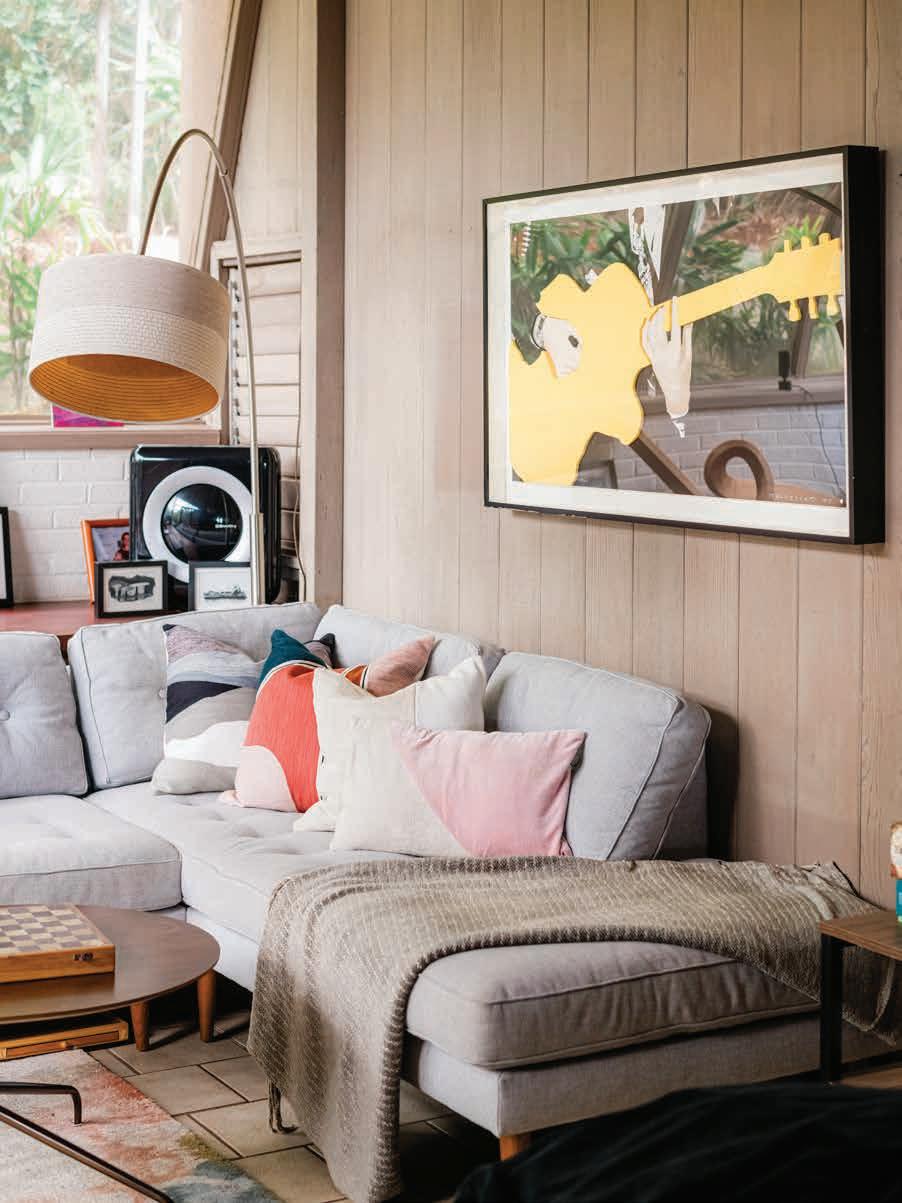
THINGS OF BEAUTY
TEXT BY LAUREN MCNALLY
IMAGES BY JOHN HOOK
29 SUEDA / CRAFT
Fine art consultant Kelly Sueda offers an intimate look into his freewheeling personal art collection.
ne of the first pieces that painter and art consultant Kelly Sueda points out from among the countless works in his collection is a Wolfgang Tillmans photograph of a woman’s armpit. “People always ask me about it,” he says, gesturing to where it hangs in his historic Ossipoff home on O‘ahu’s Wilhelmina Rise—itself a work of art that he purchased from the original owners in 2011. “Well, now we have a conversation, and boom, that opens up a whole series of other conversations where we get to know each other better.”
Many of the pieces Sueda has acquired over his decades as a collector are intended to spark a dialogue. Some, like the gallery wall of figurative paintings displayed beguilingly in the master bedroom, have seemingly found their place in the house. Other works circulate between the rooms and his and his wife’s respective offices, or they’ve been loaned freely to restaurateur friends at Bar Maze and Miro Kaimuki. Sueda routinely loses track of pieces, sometimes for years at a time, often rediscovering them hiding in plain sight throughout his home.
There’s something almost chaotic about the way Sueda collects and displays the objects he loves, works of art mingling seamlessly with the stuff of life. His schedule, too, is packed with an
inextricable mix of business and pleasure: work travel to the Venice Biennale parlayed into an excursion on the French Riviera, a ski trip to Vail bookended by a few nights of inspiration at The Art hotel in Denver. He speaks just as effusively about his latest exploits hiking the Kalalau Trail with his wife and two teenaged children as he does about James Turrell’s House of Light, which he made a point of visiting during a recent business trip to Japan, always eager for insights relevant to the large-scale installations he oversees for his many private and corporate clients.
Sueda is unusually hands-on for an art consultant, undaunted by the prospect of suspending massive wooden sails crafted by local artist Kaili Chun from a vaulted ceiling at Hawai‘i Island’s Kona Village or transporting a 2,000-pound Jaume Plensa marble sculpture across mosaic tile at a private residence near Diamond Head. “A lot of people ask, are you sad that you don’t get to paint anymore?” Sueda says. “But I always tell them, this job is so creative—working with different mediums, figuring out what works and what doesn’t. I’m constantly thinking and challenging myself.”
30 SUEDA / CRAFT

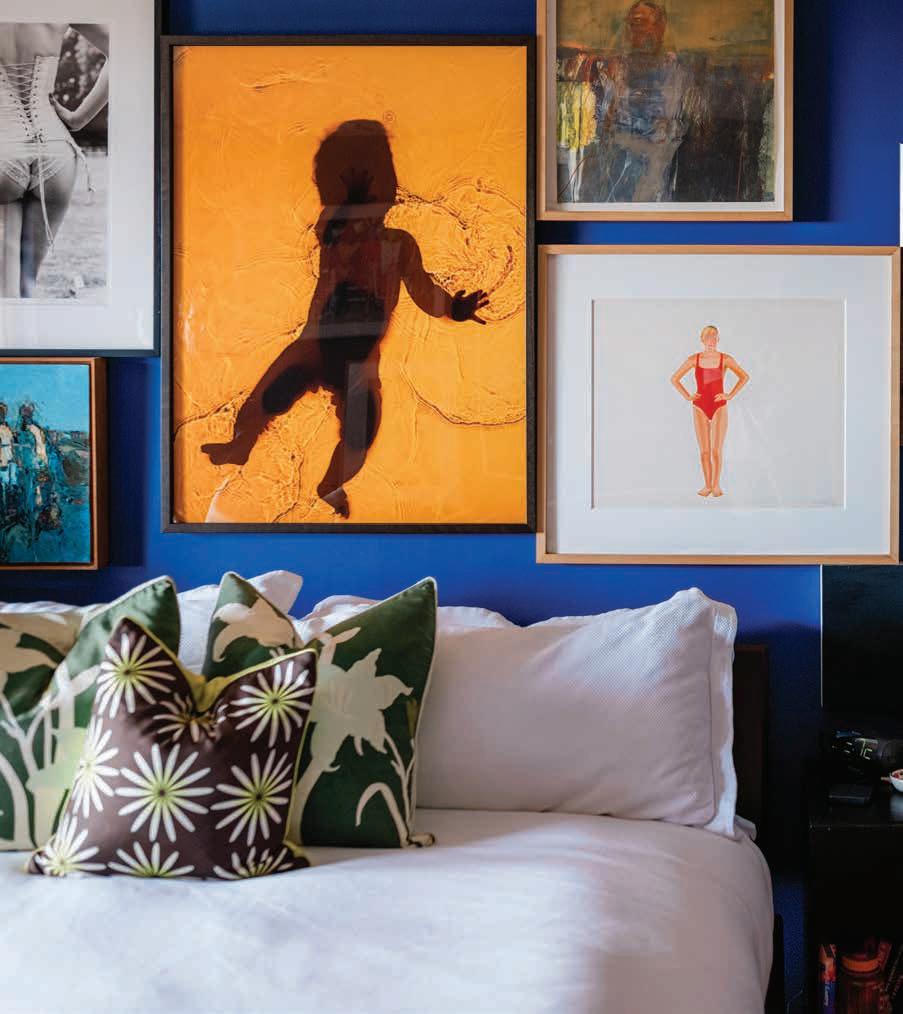
32

This One Stays
“Someone will come over, see something they like, and ask if I’ll sell it to them, and sometimes I do. But there are some pieces I won’t let go—the Nathan Oliveira in my bedroom, for example. He was one of the figurative artists that really inspired me when I was living and working in San Francisco as an artist. I’ve had so many offers on it, but I won’t sell it. I love it too much.”

33
For the Love of the Craft
“I collect art for two reasons. The first is if it resonates with me aesthetically or emotionally. The second is if I appreciate how it was made. I was a full-time painter for years before I got into consulting, so when I look at something and wonder, how the hell did they do that? Usually those are the pieces I have to have.”

34
SUEDA / CRAFT


Let’s Talk About It
“I never wanted to censor any of the art from my kids when they were growing up. You go to a museum and there are nude sculptures and paintings everywhere. It’s not a big deal. That’s my philosophy behind raising kids and living with art, too. Everything is open for discussion.”

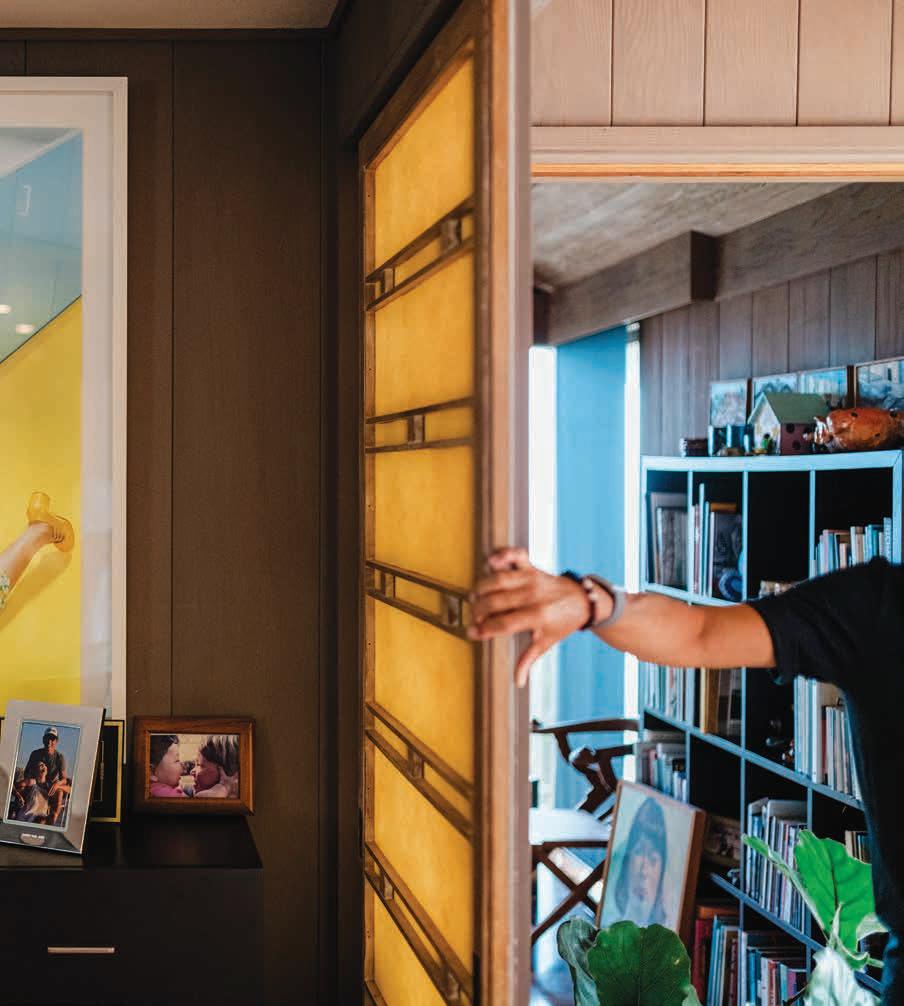
37
The One that Got Away
“I once visited the studio of artist Ning Hou, who is famous for his paintings of orchards. I ended up buying one of them, but the painting that I really loved was of an oldschool gas-station pump. I still think about that painting. The almond orchard is in my office now, but I used to display it in the house as a reminder to get art that you love, not what you think is going to be valuable later.
Like this Wolfgang Tillmans photograph—for whatever reason, I had to have it. Something about it brings me back to a hotel I once stayed at in Japan. It’s a snapshot of life: imperfect, but it speaks volumes.”
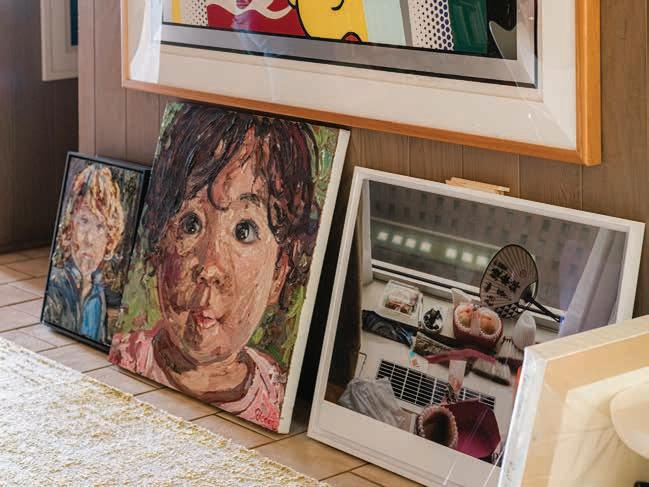
38 SUEDA / CRAFT


40
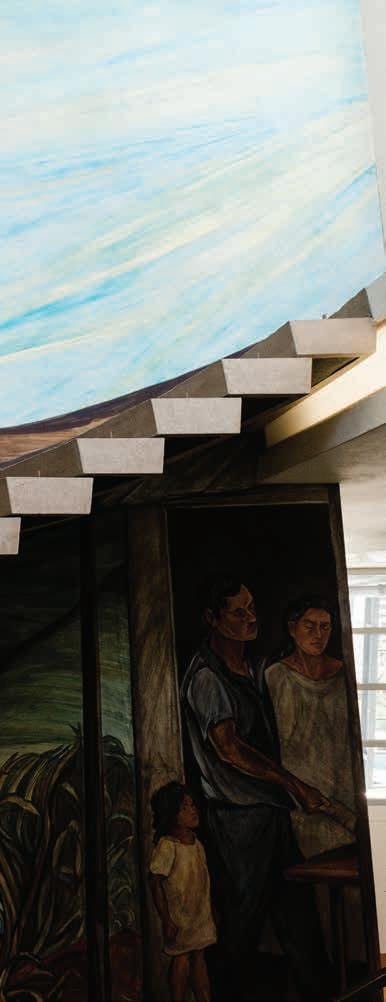
AN UNCOMMON ART
TEXT BY TIMOTHY A. SCHULER
IMAGES BY ANDREW RICHARD HARA , JOHN HOOK , AND SKYE YONAMINE

With
the sensibilities of an artist, architect Alfred Preis believed art and architecture could improve lives.
hey reveal themselves by their doors.
Walking down the dead-end street, I count one, two, three, at least half a dozen, and there are likely more, since several of the entrances are hidden behind screens or obscured by thick vegetation. The houses, in various states of disrepair, are clustered together, their paint fading in the Pālolo sun. No two are alike. Some are low and wide, with delicate wood posts supporting the eaves. Others are tall, two-story things, boldly painted to accentuate their features. And yet all of the houses share one particular detail: a door with a long, narrow window running down its center.
This door detail is one of the signatures of Alfred Preis, the Vienna-born architect who designed dozens of buildings throughout Hawai‘i between the 1940s and 1960s and frequently collaborated with his better-known contemporary Vladimir Ossipoff. When he arrived in Honolulu in 1939, having fled Europe, he was given a job at the design firm Dahl and Conrad. Preis stamped his signature on his very first house, built in 1940 on Nāhua Street in Waikīkī—a door with a fenestration just a few inches wide, a gash of glass. He used it again for houses in Mānoa and Makiki Heights, and again in central Pālolo Valley for a longforgotten project called Veterans Village.
PREIS / CRAFT 43

44

The large-aggregrate concrete at Laupāhoehoe School on Hawai‘i Island (pictured at left) was an unintentional design choice, but it became a trademark feature of Preis’ later projects, including the First United Methodist Church of Honolulu (pictured below).
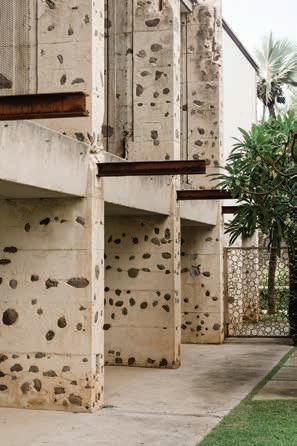
45
Veterans Village was an affordable-housing development initiated in the aftermath of World War II. It comprised 86 single-family homes on 14 acres on either side of Pālolo Stream. All were designed by Preis, who after the war—during which he was briefly interned at Sand Island in Honolulu alongside fellow Austrians, Germans, and Japanese residents—left Dahl and Conrad and opened up his own office in Honolulu. The price of homes in Veterans Village began at just $7,500 (or $75,400 in today’s dollars). Nearly 70 years later, many of the houses still stand.
Today, Preis is best remembered as the architect of the USS Arizona Memorial, that iconic vessel that floats ghostlike over the sunken battleship in Pearl Harbor, but he spent a great deal of his career designing modest projects on modest budgets. He was concerned with progressive issues like the labor movement and fought to improve the quality of the built environment. “Preis’ clients were, for the most part, locals,” says Laura McGuire, an architectural historian and coauthor of the 2022 Preis biography Alfred Preis Displaced “He tended more toward a desire to make a kind of Hawaiian modernism for the people.”
Among Preis’ earliest projects was the Labor Canteen, a cafeteria and event space for members of local labor unions, which was located at the corner of Kalākaua Avenue and Beretania Street. He also designed buildings in Hilo, Līhu‘e, and Honolulu for the International Longshore and Warehouse Union, the last of which features a dramatic, cantilevered stair and a three-story mural by Pablo O’Higgins, who was part of the Mexican mural movement and an associate of
Diego Rivera. The slightly bowed building, located on Atkinson Drive and built in 1952, was both of its time and ahead of it, with a coffee shop and a rooftop garden alongside the dormitories for laborers.
Preis’ politics were informed by his childhood. He grew up in a working-class neighborhood, the eldest son of a Jewish family that had converted to Catholicism. He came of age in the Austrian capital during the 1920s, a period in which the socialist government funded the construction of more than 60,000 units of public housing, when the city was known as “Red Vienna.” Preis fled the country just months after the Nazis annexed Austria, narrowly escaping the horrors of the Holocaust, which claimed the lives of both his parents.
If Vienna instilled in Preis a deep-seated belief in the merits of socialism, it also inspired a lifelong passion for the arts. He loved the theater. His earliest aspiration was to become an actor, and before architecture, he had considered a career in stage design. This fascination with art is apparent in Preis’ work, not only in his attention to detail and love of bright and contrasting colors, but also in the way he made provisions for art in even the most modest of projects. Along with the house on Nāhua, for instance, Preis designed an eight-unit apartment building on the same property that included built-in frames he filled with prints by the artist John Kelly. “That was his thing. He was committed to art in architecture,” says Jack Gillmar, a retired schoolteacher and another of the Preis biography’s coauthors.
Gillmar should know. He grew up in the house
PREIS / CRAFT
46
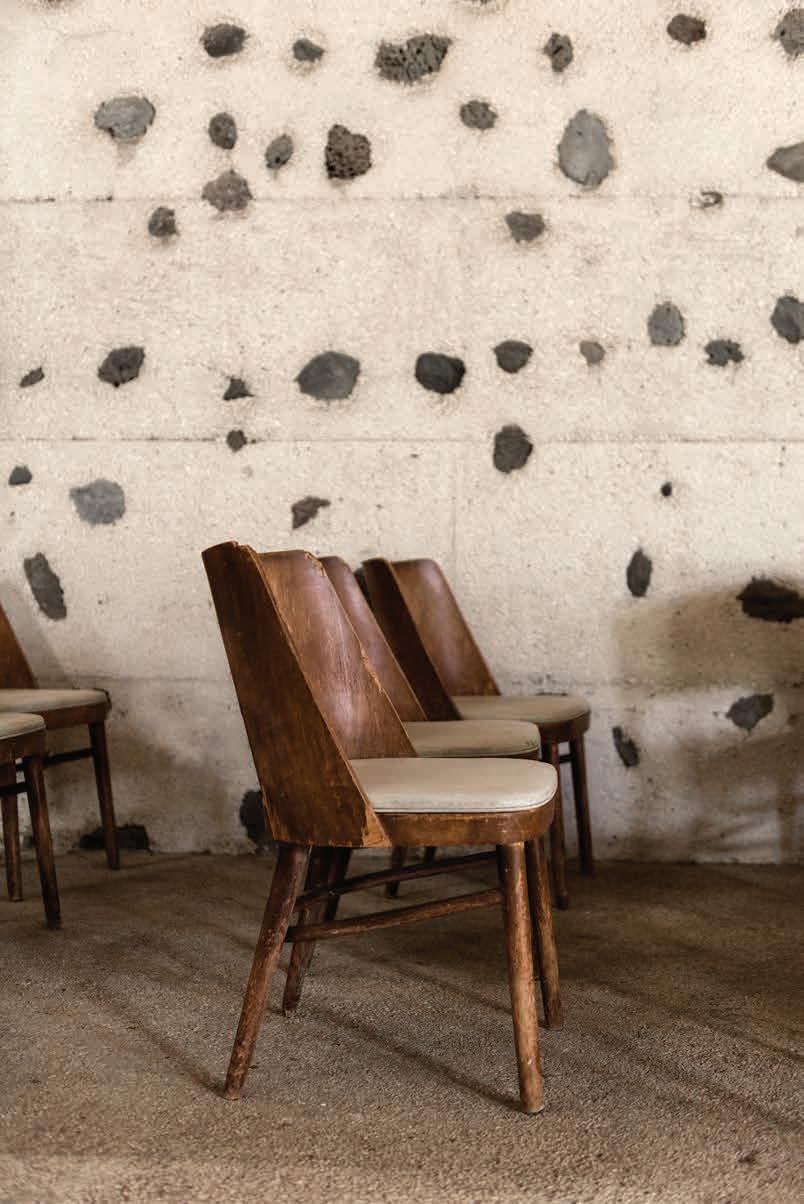


on Nāhua Street, a modern, two-story box with a rounded plaster facade. Inside, it was full of custom details, including carved wooden drawer pulls and a mahogany staircase. In 1974, Gillmar and his wife, Janet, who is an architect, sold the property but decided to keep the house. They dismantled the structure piece by piece, labeling every tread, cabinet, railing, and door. They sawed the sandstone fireplace out of the wall. They took the staircase, the built-in bookshelves, the chrome bars that symbolically divided the living area from the dining.
They trucked everything to the back of Pālolo Valley and put the house back together, enclosing its orphaned interior in a new, more contemporary shell. It took the couple 15 years. When it was finished, they invited Preis and his wife, Jana, to lunch at the reconstructed house. “He was astounded,” Jack Gillmar recalls. “He was astounded that we saved it, that we put it back together, and he was even grooving on some of his own details. It was like his first child.”
Gillmar remembers Alfred Preis as a quiet, selfeffacing person. “He never made a big deal about himself or what he contributed,” Gillmar says. “But in terms of architecture, he contributed a great deal.” Yet Preis’ legacy lay less in individual buildings and more in his advocacy for the value of good design. He championed the preservation of Hawai‘i’s natural beauty and chaired multiple committees dedicated to the protection of places like Diamond Head. In 1963, Preis became Hawai‘i’s first-ever statewide planning coordinator, bringing aesthetic considerations to bear on large-scale infrastructure projects such as Queen Ka‘ahumanu
Preis’ legacy lay less in individual buildings and more in his advocacy for the value of good design.
Highway on Hawai‘i Island and the Pali Lookout on O‘ahu.
In 1965, Preis helped found the Hawai‘i State Foundation for Culture and the Arts, for which he served as executive director until 1980. It was because of Preis that Hawai‘i became the first state in the nation with a statewide “percent for art” law, which earmarks 1 percent of all state construction spending for the commission or purchase of public art. During his tenure, Preis oversaw the purchase of more than 2,000 original works of art, including pieces by renowned artists such as Satoru Abe and Barbara Hepworth. Many remain on public display.
In this way, Preis had an outsize impact on Hawai‘i’s built environment. It also closed the circle. Preis had dreamed of being an artist, and he never lost faith in the notion that art and architecture could improve lives. Studying the homes at Veterans Village, each one with its own unique details, the craftsmanship is almost shocking. That an architect would put so much thought and care into low-income housing was— and remains—a radical act. But that was Preis. For him, architecture was a public good, not a luxury. “He was extremely hard-working, extremely dedicated,” Gillmar says of the man. “He was willing to give his all for the people.”
50 PREIS / CRAFT


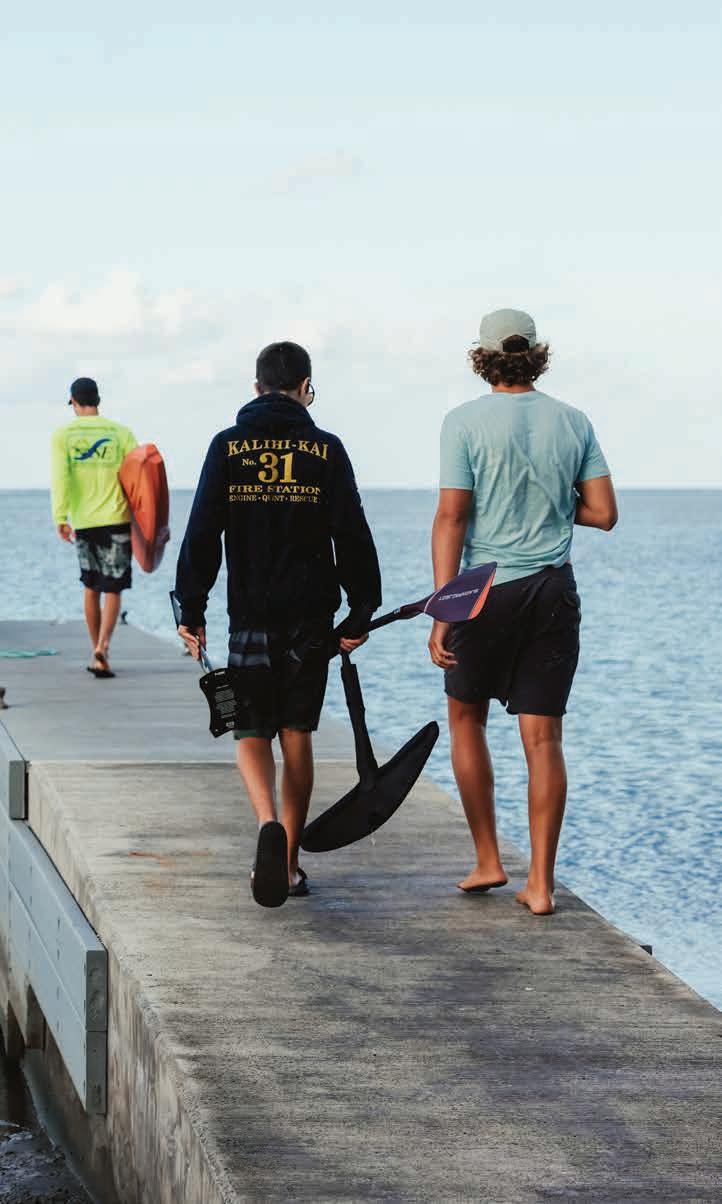
DISCOVER 53
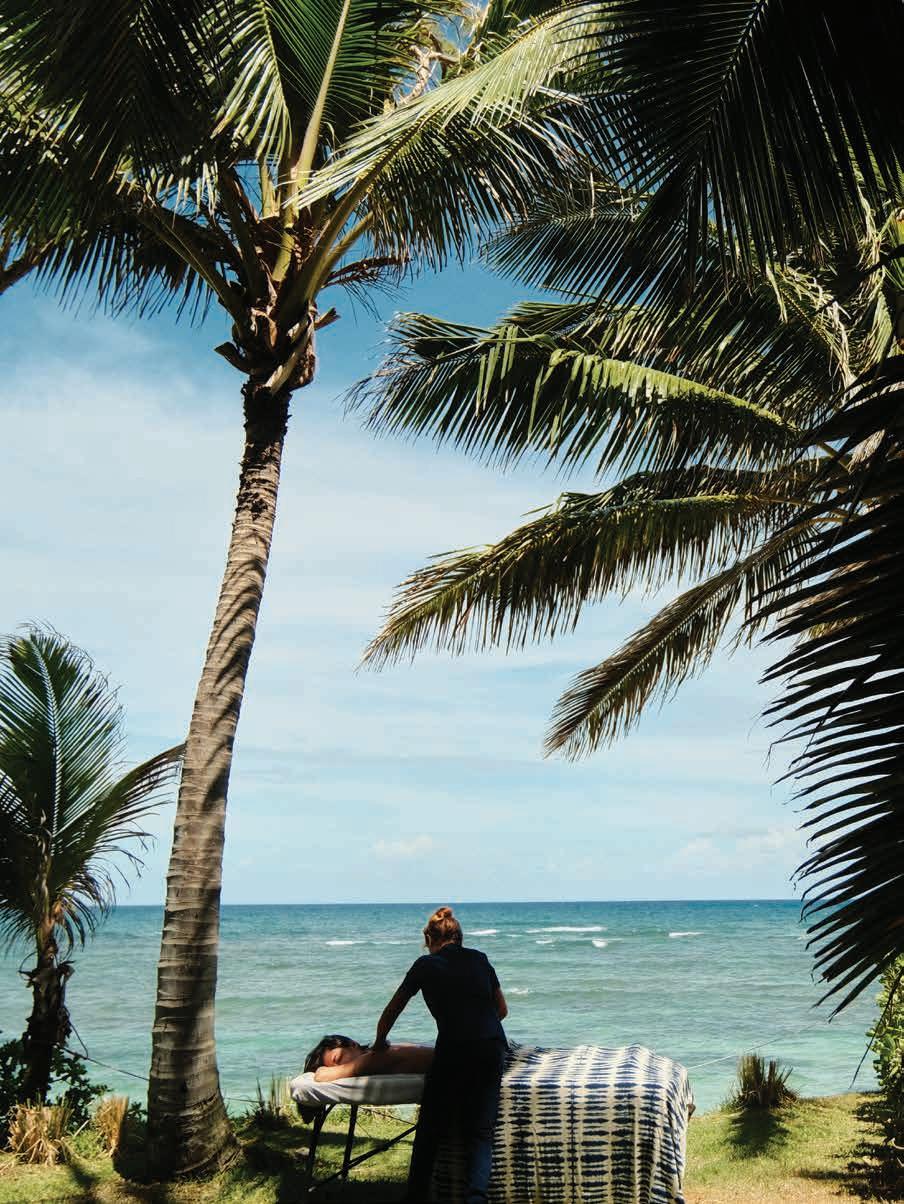 IMAGES BY BLAKE ABES
IMAGES BY BLAKE ABES
In this photo essay set on O‘ahu’s north shore, experience a stay at Makana at Mokule‘ia, a 1.25-acre vacation home tucked along a quiet lane in the former plantation town of Waialua. Here, the sun spills over the Ko‘olau mountain range, bringing sublime days that can be filled with any number of exploits by land and sea. Ahead, find some of the ways you might fill the languid hours between sunup and nightfall.
A PERFECT DAY / DISCOVER 55
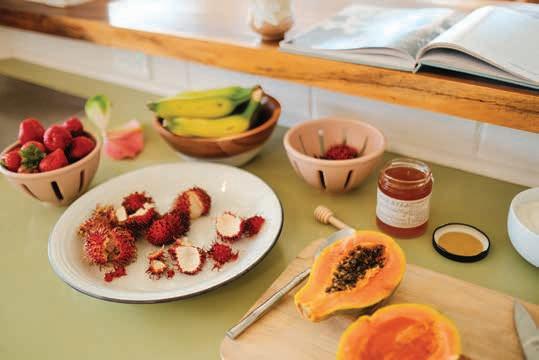
: 00 AM
8
A PERFECT DAY / DISCOVER 56
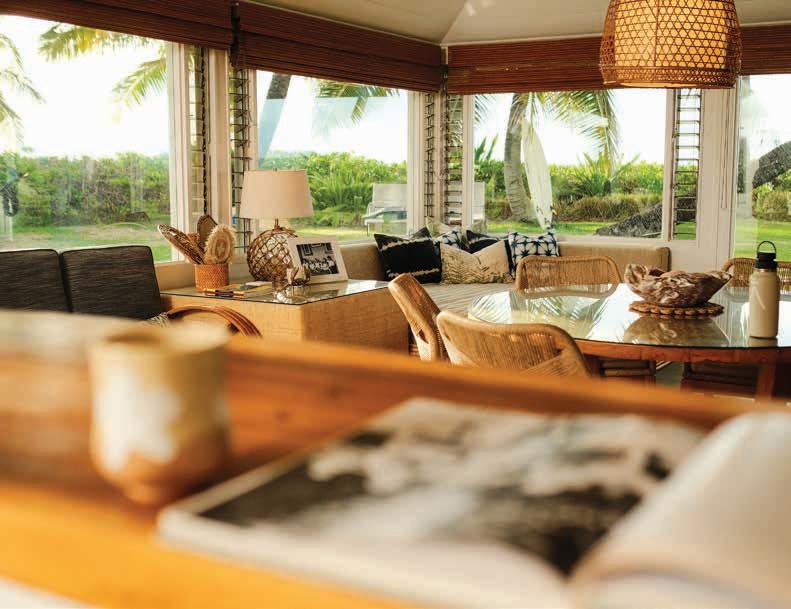

57
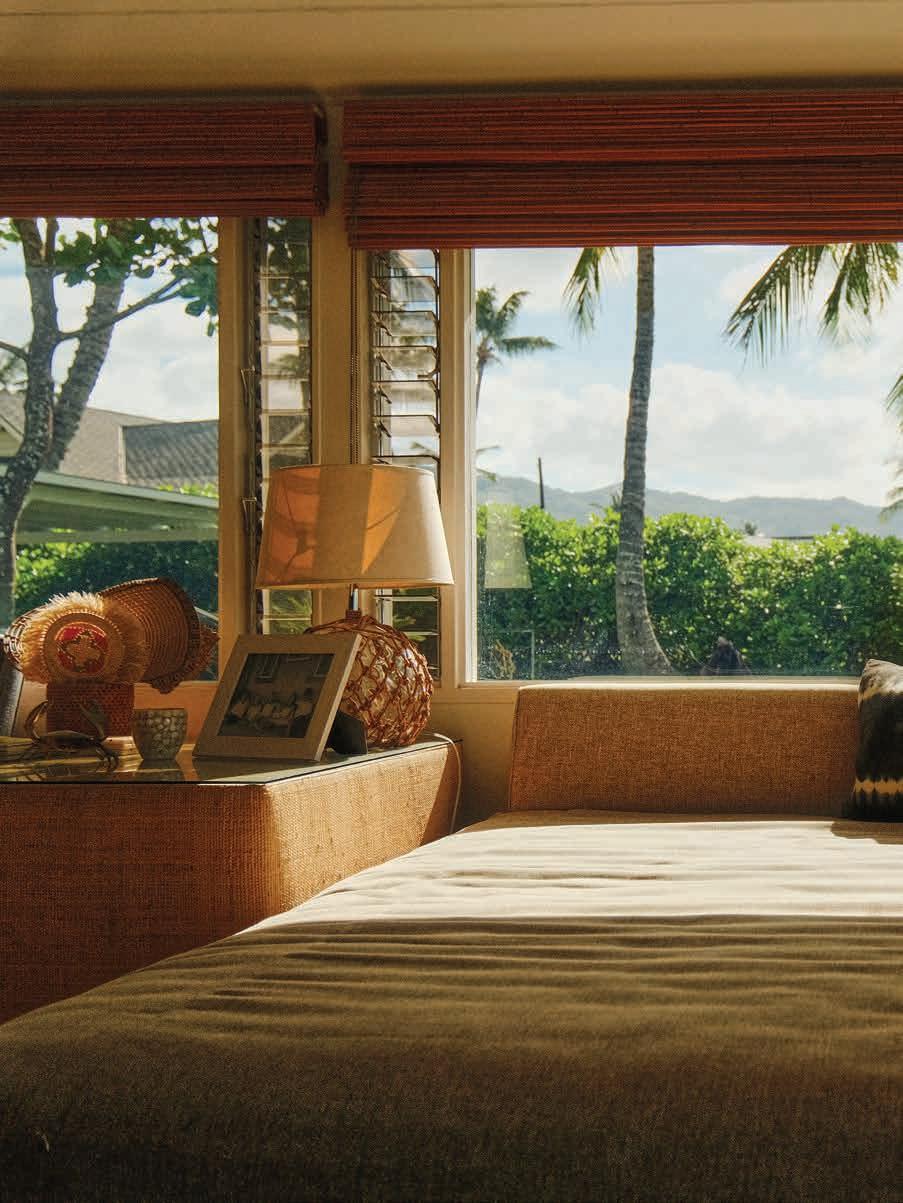

: 00 AM

10
A PERFECT DAY / DISCOVER 60

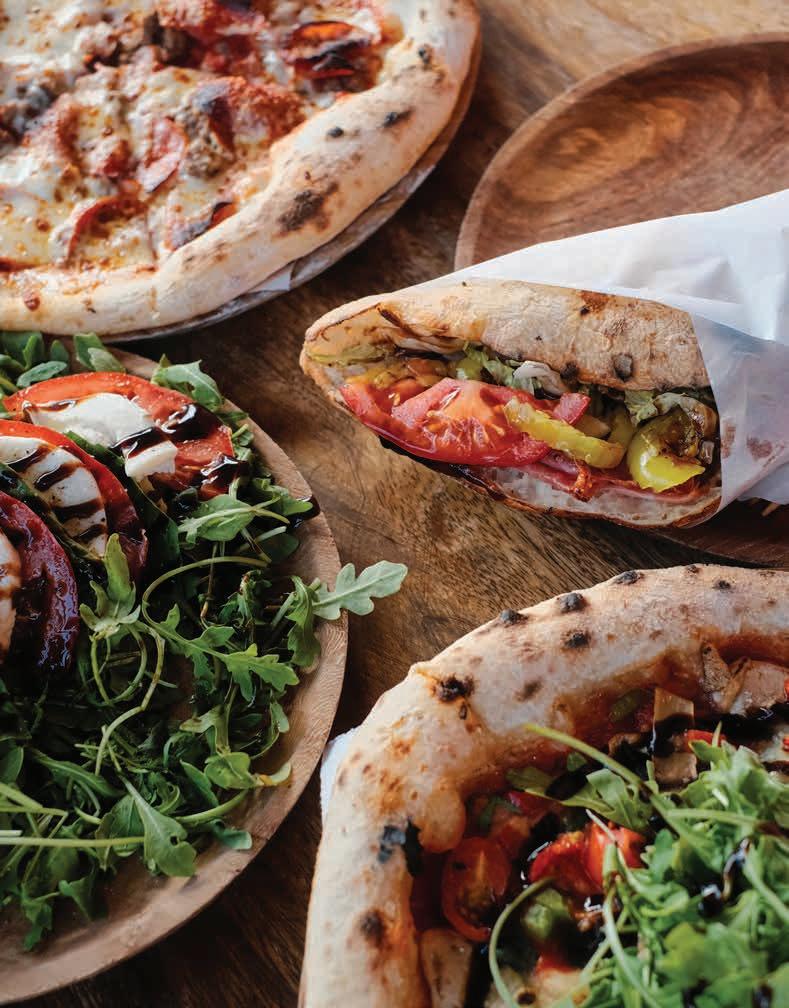

12: 00 PM A PERFECT DAY / DISCOVER 63
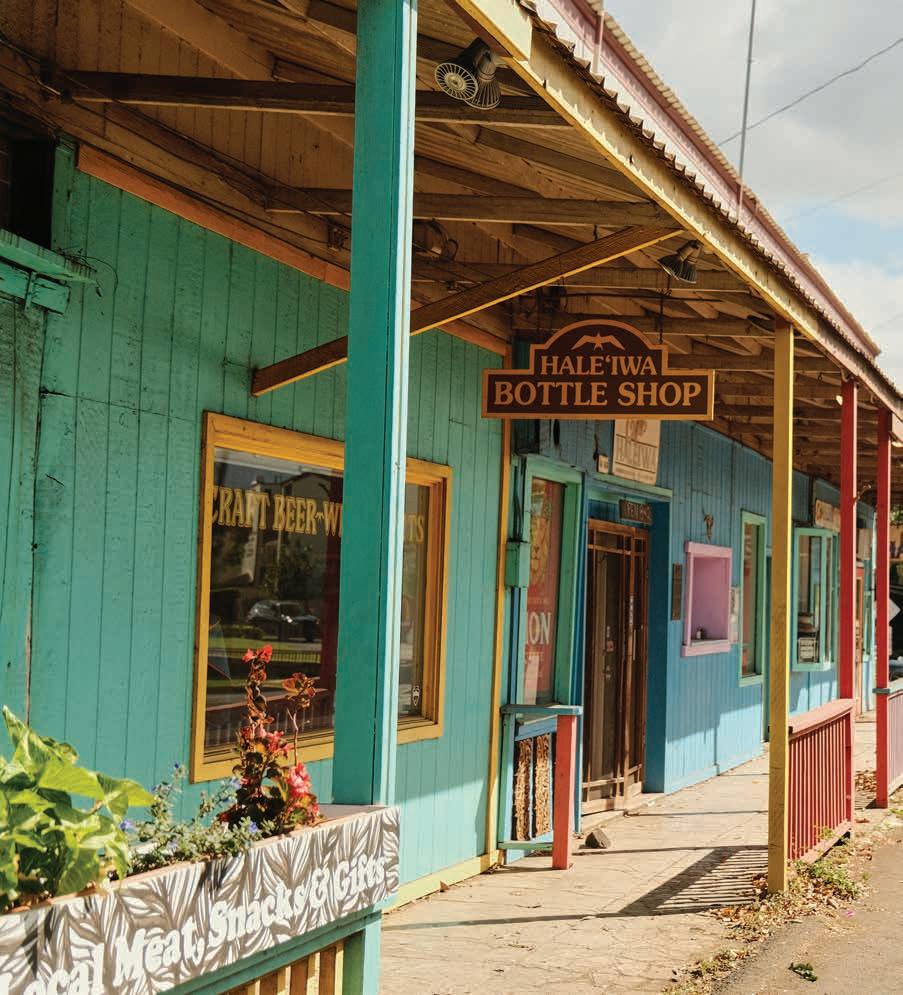

2: 30 PM A PERFECT DAY / DISCOVER 65

4
A PERFECT DAY / DISCOVER 66
: 00 PM



6: 00 PM A PERFECT DAY / DISCOVER 69
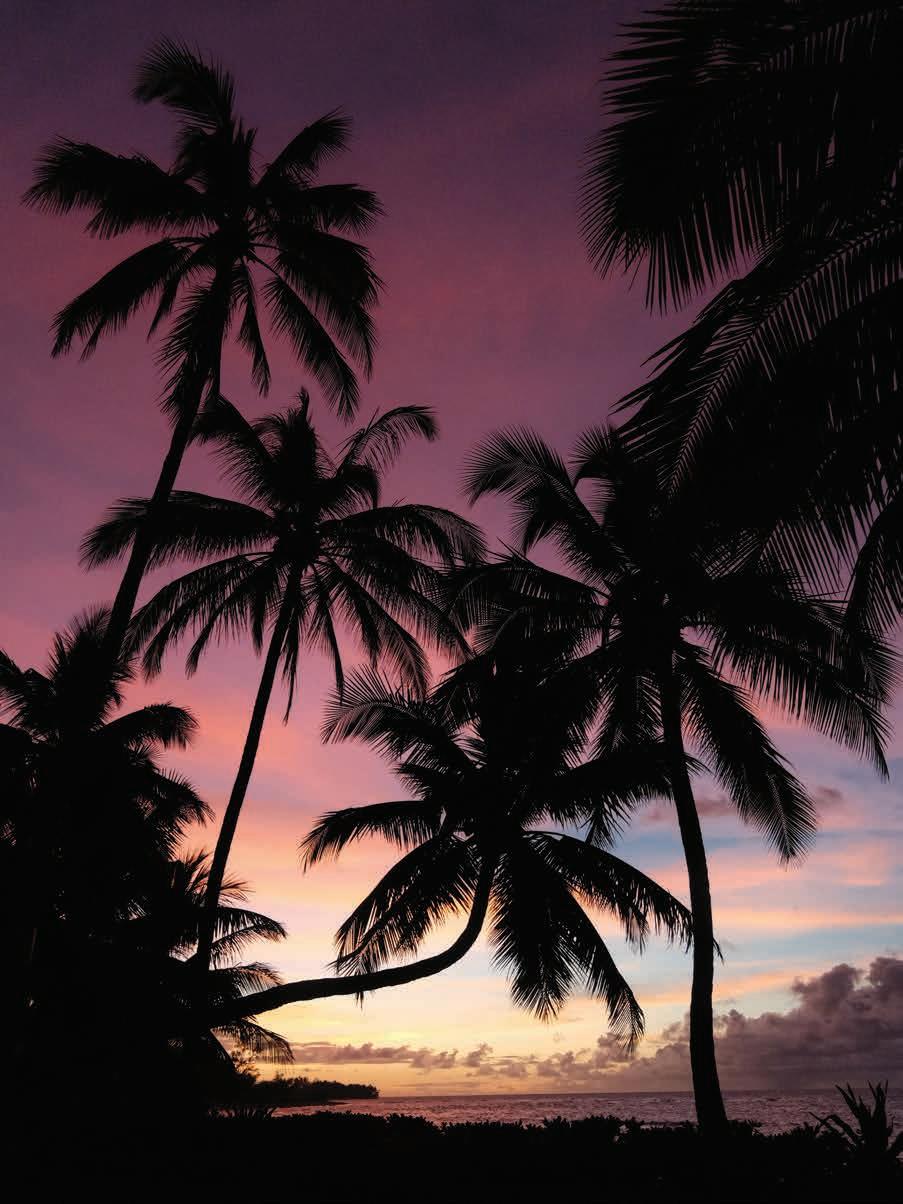
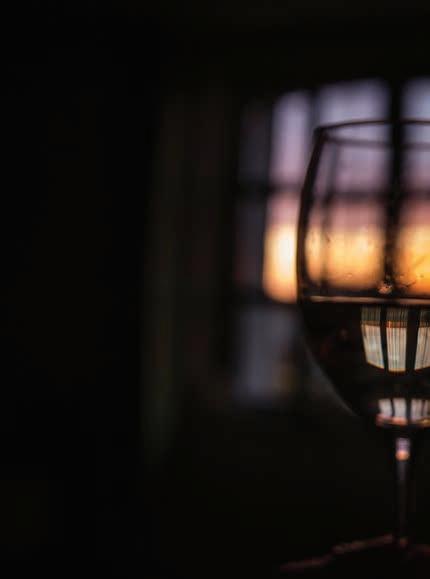
7: 30 PM A PERFECT DAY / DISCOVER 71

72

THE CHANNEL CROSSER
AS TOLD TO RAE SOJOT
IMAGES BY MATTY LEONG AND MICHELLE MISHINA
O‘ahu native and consummate waterman Jack Ho recounts his triumphant journey crossing the Ka‘iwi Channel at the 2023 Moloka‘i 2 O‘ahu Paddleboard World Championships.
ike many other town kids, I learned to surf in Waikīkī at Baby Queens with my dad pushing me on a board and teaching me how to stand up. From there, it evolved into longboarding and shortboarding with my friends and surfing bigger waves. Around the time I felt like I was getting good at surfing, foiling came along.
I tend to zero in on the things I like, and with foiling, I just wanted to do it all the time. I was always asking, how can I get better? How do I progress? Foiling required full commitment and dedication.
By the time I entered the Moloka‘i 2 O‘ahu, I had prior experience and knowledge from other races, but the Ka‘iwi Channel—its name, stories, and legacy—leaves a mark on every racer. It is one of Hawai‘i’s roughest channels, and to cross it is to accomplish something meaningful.
Unlike the Maui to Moloka‘i race, where you can see exactly where you’re going, with the M2O you can’t see O‘ahu at the race’s start. You just head into the horizon toward an indistinct outline in the clouds. It’s only in the last five to ten miles that O‘ahu finally becomes noticeable, and you
MOLOKA‘I 2 O‘AHU / DISCOVER 74

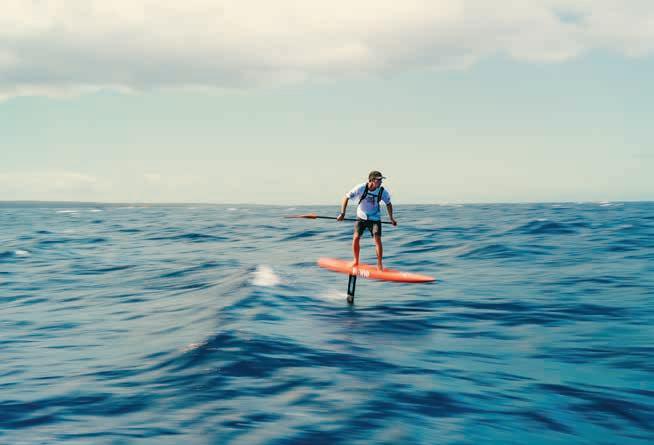
can spock out landmarks such as Sandy Beach or Rabbit Island. But for most of the race, it’s just you and the ocean.
With a traditional paddleboard, you have to physically haul the whole race and work the entire time. But with a foil, its efficiency allows you to ride swells. Once you get on, there’s a sense of calm, and you’re basically playing connect-the-dots, weaving into swell after swell. It’s almost relaxing, soothing. The wind acts like a support, moving past you and pushing you along the course. At a certain speed, your foil creates a sound like a hum or a whistle. Once you hear that, you know you’re going really fast.
When I finished the M2O, I immediately felt a sense of pride and accomplishment at having completed something that I had been working so
hard toward. I saw my journey too: First learning how to ride a wave in Waikīkī at 5 years old to now riding waves and crossing the channel in two hours. It’s still shocking to me. Like, wow, I did that.
Now, when I think back, I think about how beautiful the Ka‘iwi Channel is, how there’s so much energy. The water is a deep blue, made even bluer by the sun. When you look down, that blue becomes purple. There’s definitely a spiritual presence when you’re out there, whatever you believe in.
There are so many flying fish too. On my usual coast runs, you normally see 3- to 4-inch flying fish, but in the channel, they’re huge—8 to 12 inches. When you’re on the foil, you feel like you become one of them. You’re soaring along in the swells, and they’re right next to you, going just as fast.
76 MOLOKA‘I 2 O‘AHU / DISCOVER
Jack Ho and friends head out for a practice run in preparation for the 2023 Moloka’i 2 O’ahu World Championships.


An accomplished all-around waterman and recent recipient of the prestigious 2023 Duke Award from the Outrigger Duke Kahanamoku Foundation, Jack Ho is part of the vanguard in the sport of foiling. His 2024 race slate includes the Maui to Moloka‘i Challenge, Moloka‘i 2 O‘ahu, and the Gorge Paddle Challenge in Hood River, Oregon.
78 MOLOKA‘I 2 O‘AHU / DISCOVER


80
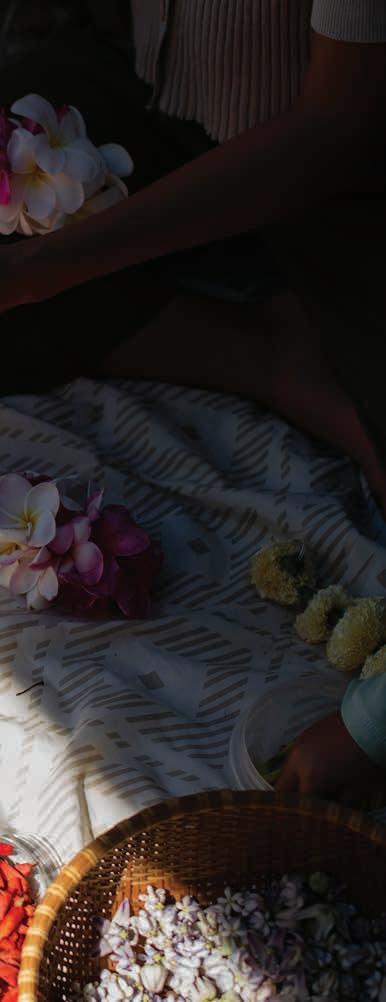
STRONGER TOGETHER
TEXT BY MICHAEL KEANY , HAWAI‘I COMMUNITY FOUNDATION
IMAGES BY ELYSE BUTLER AND SEAN MARRS
In the wake of the fires that devastated parts of Maui, hundreds of nonprofits, community groups, and businesses rose to meet the challenge.
hen news broke that wildfires were tearing through parts of Maui in early August 2023, it was immediately clear that, for many on the island, life would never be the same. Within hours of the initial blaze, the Hawai‘i Community Foundation (HCF) sprang into action, swiftly activating its Maui Strong Fund to provide financial resources to meet the immediate and long-term recovery needs for the people and places hardest hit. Over the first month of relief efforts, HCF worked in close collaboration with state and county leaders, nonprofit organizations, and community members to get an understanding of the quickly evolving priorities, distributing more than $17 million to almost 100 partners working on the ground to meet the community’s urgent needs, including animal welfare, food and supplies, shelter and lodging, mental health and grief counseling, and more. Over the coming months and years, HCF will continue to administer grants from its growing Maui Strong Fund, which saw nearly $138.5 million in donations as of early October 2023.
With its 105-year history of working with a vast network of organizations to address the root causes of Hawai‘i’s most difficult challenges,
HCF is uniquely poised to help fuel Maui’s ongoing recovery. Here are the stories of just a few Maui Strong Fund grantees who responded in Maui’s time of greatest need.
common ground collective
On August 9, 2023, thousands of people on Maui found themselves without the basic elements of survival: shelter, food, water. The human need was immediate, and it was huge. To meet that need, Common Ground Collective, a nonprofit dedicated to increasing food security on Maui, partnered with the University of Hawai‘i Maui College and Chef Hui to prepare much-needed meals for those affected by the fires.
Together they cooked between 8,000 to 10,000 meals a day, which were then distributed in shelters and impacted neighborhoods. As of August 25, 2023, 92,000 meals had been produced with the support of a grant from the Maui Strong Fund.
Many local farmers donated produce, and local chefs also volunteered their time, including Sheldon Simeon of Tin Roof in Kahului and Tiffany’s in Wailuku; Lee Anne Wong of Koko Head Café in Honolulu and Papa‘aina Maui
MAUI STRONG / DISCOVER 82
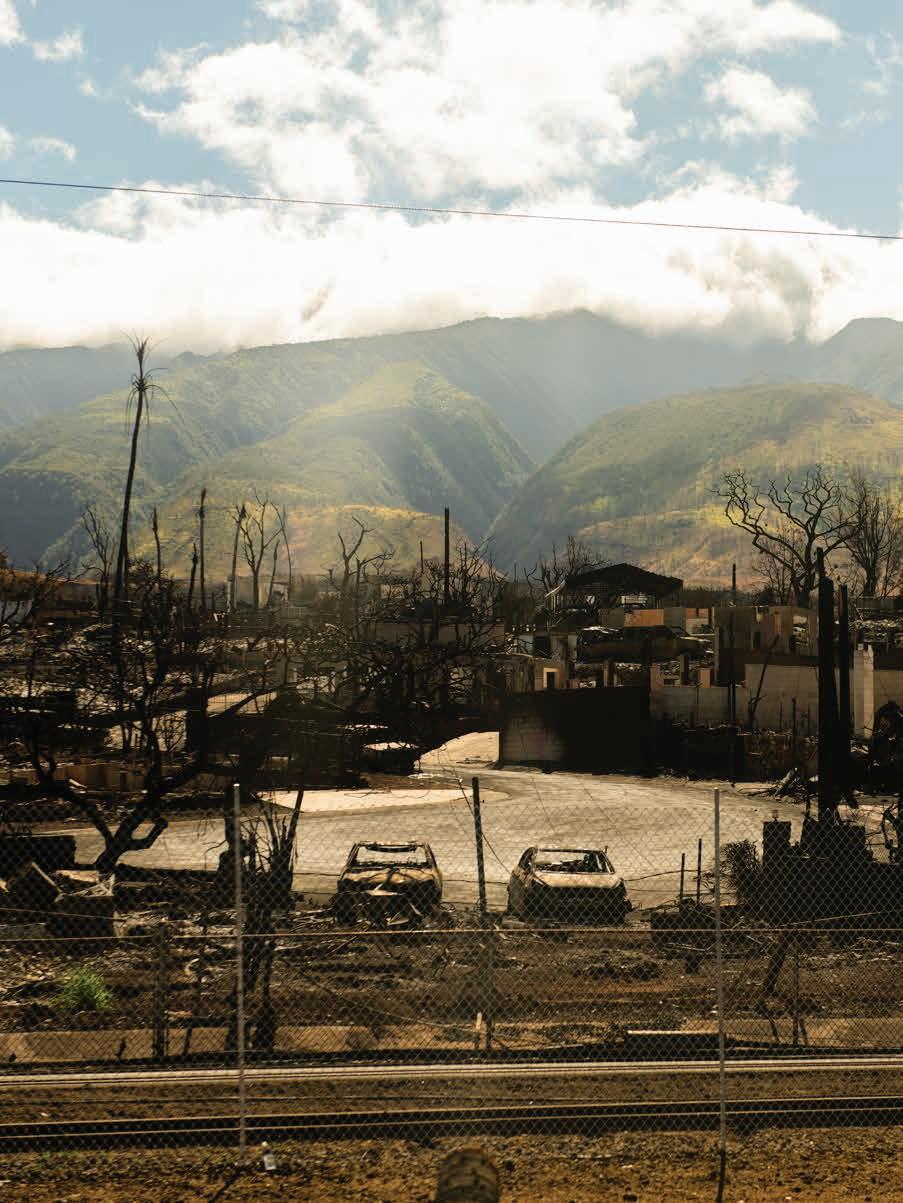

MAUI STRONG / DISCOVER 84
We have a lot of local chefs helping, and some of them actually lost their own restaurants.
in Lahaina; Taylor Ponte of The Mill House in Waikapū; and Craig Omori, chef instructor at the University of Hawai‘i Maui in Kahului.
“We have a lot of local chefs helping, and some of them actually lost their own restaurants,” says Jennifer Karaca, executive director of Common Ground Collective. “They’ve been here cooking, even though they’ve experienced tremendous loss of their own. … Everyone is still showing up, putting so much work and heart and energy into the community. That’s what gives me hope, because I know we’re all going to work together to make sure we see this through.”
In all, Common Ground Collective helped purchase and procure over 100,000 pounds of locally grown produce and proteins to support local producers. It has since transitioned to supporting meal distribution efforts in Wailea, Olowalu, and other community hubs such as Pōhaku Park and Nāpili Park. It’s also working with the county and state to help create long-term feeding and food systems plans.
hawai‘i animal rescue foundation
After the fires, many displaced into transitional housing were unable to bring their pets with them. Others were separated from their animals
while escaping the fires. With the support of HCF’s Maui Strong Fund, the Hawai‘i Animal Rescue Foundation (HARF) stepped in to provide food, shelter, and medical care for dogs, cats, and farm animals evacuated from fire zones and no longer under the care of their owners.
For those displaced residents unable to care for their pets, HARF has committed to caring for the animals at its Waihe‘e facilities for however long is needed or, if requested, finding them permanent homes. When the need for shelter was at its peak in late August 2023, HARF was housing a rotating population of about 100 pets.
“Every animal we’ve taken in so far has been in from a family that has lost their home or been semipermanently evacuated from the Lahaina area,” said HARF CEO and co-founder Dawn Pfendler in late August 2023. “They didn’t know where they were going to stay, what they were going to do. We’ve been able to give their pet a soft landing place so they don’t have to worry about it, and they can come visit their pet anytime they want.”
In addition to its boarding services, HARF also traveled with veterinarians into the Lahaina community to treat animal medical needs on site, and the organization has been working closely with the Maui Humane Society to coordinate response efforts.
pacific birth collective
Maui nonprofit Pacific Birth Collective (PBC) was established seven years ago with the goal of creating an effective, comprehensive network of Maui care providers of pregnancy, birth, and postpartum
85
services—everything from doulas and midwives to bodyworkers and nutritionists.
When news broke of the devastation caused by the fires across Maui, PBC acted quickly, using grant money from the Maui Strong Fund to purchase a mobile care unit dedicated to providing essential care and support to pregnant, birthing, and postpartum families in Lahaina and Kahakuloa who have been displaced and negatively impacted.
“We quickly saw the need to get out to the West Side mamas to get healthcare to them directly,” says PBC board president and co-founder Sonya Niess. “There are quite a few community members, pregnant women, who are wanting to stay on the West Side, in their homes. They don’t want to leave. The mobile unit allows us to meet the people where they’re at. And that is something we’re excited about.”
PBC also converted its office space in Ha‘ikū into a donation and distribution center for much-needed supplies, including formula, diapers, menstrual products, clothing, and medical supplies.
According to Niess, the outpouring of support and generosity has been overwhelming. “The messages we receive from families who have accepted the goods that they need are so heartwarming,” she says. “It really hits the heart of why we’re doing the work we’re doing.”
nā keiki o emalia
While the immediate impacts on Maui have been devastating, one of the biggest challenges, for many, will be the quieter one ahead: grief. For
children, especially, the loss of a family member at such a crucial stage in their development can be shattering to their long-term emotional well-being. The nonprofit Nā Keiki o Emalia is working to make a difference in this delicate time, offering direct grief support services for children, teens, and families affected by the Maui fires. The nonprofit is providing peer-to-peer support groups for children and teens, along with separate groups for their parents and guardians, while also providing toys, art activities, food, and other supplies through a drop-in space at its office near Maui Memorial Medical Center.
It can be challenging to get people to talk about grief, says executive director Carole Zoom. “We’re working to make it a more normalized conversation,” she says. “Because while basic needs are the immediate priority in the beginning of a disaster, unresolved grief can lead to truancy from school, social disconnection, and other long-term impacts that none of us want to see. We’re here to try to intervene and make it better. As kids start thinking and talking about their losses and experience grief, we’re going to be there for them, now and in the long haul.”
A week and a half after the initial fires, Nā Keiki o Emalia hosted an event for grieving children and teens, providing toys, books, art activities, kittens for cuddling, backpacks full of supplies, and more, as well as grief resources for families. Attendance was strong, which Zoom says is a testament to the great need facing Maui’s communities right now: “After this disaster, we have hundreds of children and families who will be grieving a recent death, which is going to potentially change the shape of our island for years.”
86 MAUI STRONG / DISCOVER
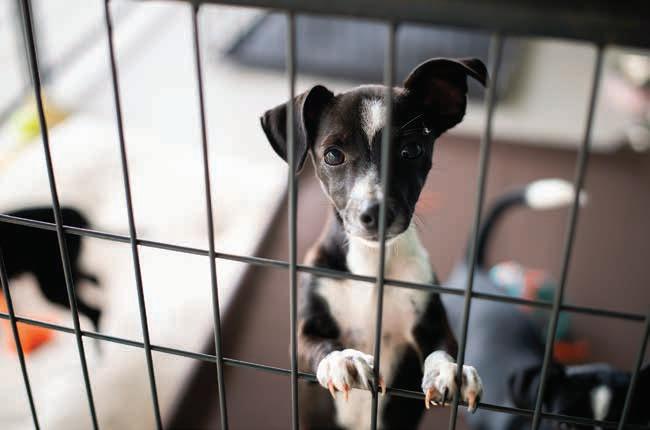
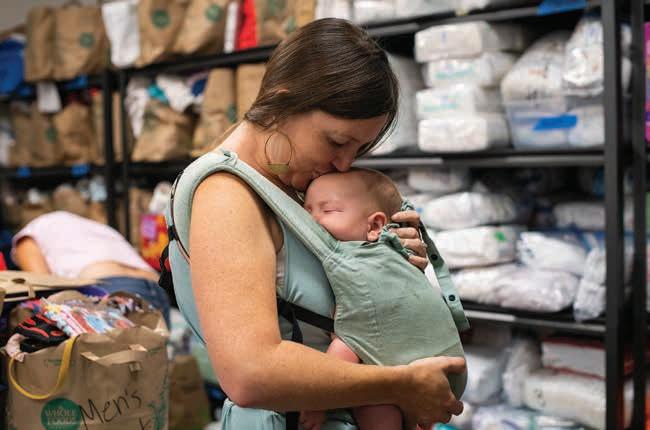
87

88
maui nui resiliency hui
“In a disaster, what you typically think of is food, water, shelter, but we learned that communication almost took precedence over that,” says Kai Nishiki, co-executive director of Maui Nui Resiliency Hui (MNRH). “Because, really, you don’t care if you’re hungry, or you’re thirsty. You care if you know that your child is alive, or you can reach your friends and family and find out that they’re OK. And so that took precedence over anything else.”
As soon as Nishiki and other members of MNRH realized the need, they began working urgently to acquire and install standalone power stations and Starlink terminals in neighborhoods across West Maui, providing critical charging and Wi-Fi internet services to individuals and families who found themselves without cell and internet service in the aftermath of the Lahaina fire. With the support of a Maui Strong Fund grant, and in collaboration with partners such as Red Lightning and Elcco Electric, MNRH has set up more than 100 stations, with plans to install more as needed.
One of the first Starlink stations was set up at the Nāpili Park resource hub, which has been providing basic supplies and a range of social services, making it a convenient one-stop destination for those who live in the area. “The needs here are very fluid,” Nishiki says. “They’re changing and evolving every single day. And so we’re responding to the new needs that people now have, as they come up. We’ve heard from so many people who are so grateful to have had a way to reach their families and let them know they’re OK.”
Each of these Maui organizations working toward the recovery and rebuilding of Maui has been supported by grants from the Maui Strong Fund of the Hawai‘i Community Foundation. The Maui Strong Fund is providing financial resources to support the island’s immediate and long-term recovery needs, using a four-phase approach that recognizes the importance not only of rapid relief and response, but of continuing efforts toward recovery and stabilization, and of rebuilding resilience in the years to come.
To learn more about the Maui Strong Fund and how you can help support Maui communities affected by the fires, visit hawaiicommunityfoundation.org/maui-strong
MAUI STRONG / DISCOVER 89

90
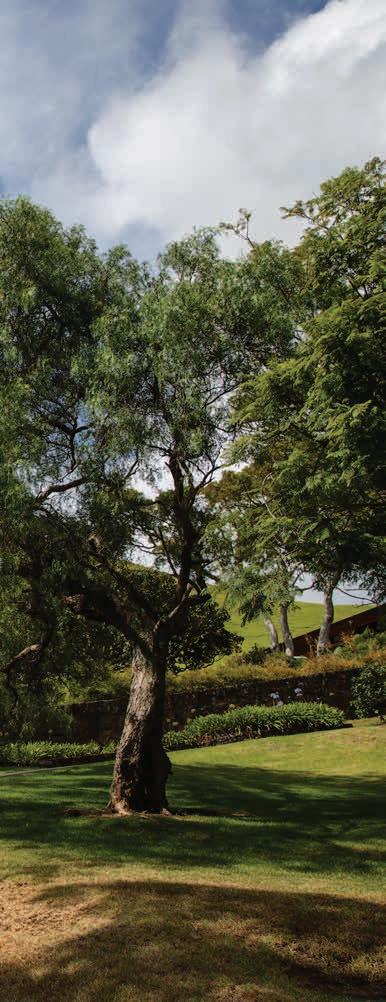
Greener Pastures
TEXT BY JEANNE COOPER
IMAGES BY NANI WELCH KELI‘IHO‘OMALU
In the ranching community
of Waimea, rustic charm and otherworldly beauty abounds.
he first time you drive from the sunbaked resorts along Hawai‘i Island’s Kohala Coast to upcountry Waimea, you may wonder if you’ve landed in the Hawai‘i equivalent of Brigadoon, the mythical hamlet suspended in time within the Scottish Highlands, appearing to outsiders but once a century in the Broadway musical of the same name.
Waimea’s towering green pu‘u (cinder cones), lush with pastures and forests and often wreathed in mist, make for a backdrop as dramatic as any theatrical production. The presence of 176-yearold Parker Ranch—the largest ranch in Hawai‘i at 130,000 acres—ensures unimpeded vistas of majestic volcanic mountains and the preservation of paniolo (cowboy) culture, evolved from the customs of Mexican vaqueros who arrived here in the early 19th century. Named for the Hawaiian pronunciation of español, the paniolos came to manage the descendants of wild-roaming cattle imported by Captain George Vancouver, who gave them to King Kamehameha in 1793.
“We are a ranching community, and we need to keep that at the forefront of who we are,” says Susy Chillingworth Ruddle, a philanthropist and long
WAIMEA / DISCOVER 92

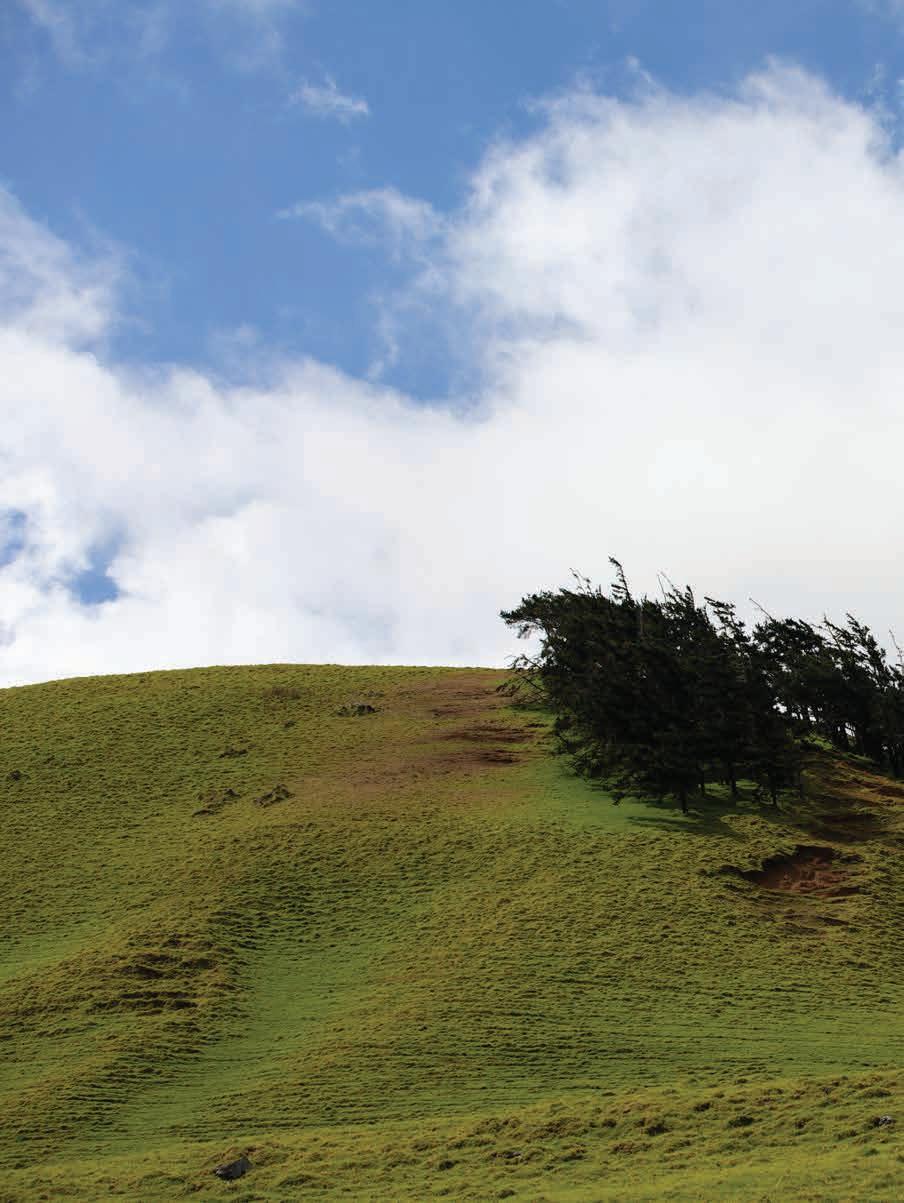


96
time resident who grew up on O‘ahu but whose family ties to the area date to the 1850s. Riding horses around town in childhood, she and her cousins embraced the local version of Brigadoon’s tartans: palaka, a sturdy plaid cotton shirt originally worn by Native Hawaiian ranch hands and Japanese and Okinawan plantation workers. “We wore palaka everything,” reminisces Ruddle, who lives today off Ahuli Circle, one of many older neighborhoods on former Parker Ranch land. “I love that it’s old and every house has a story in it,” she says of Ahuli Circle. “I love that the walls speak.”
Ruddle moved to Waimea permanently several decades ago so her son could attend Hawai‘i Preparatory Academy (HPA), an elite private day and boarding school in Waimea with two campuses for its pre-K through 12th-grade students. Today students hail from all over the state and the globe, competing on sports teams as Ka Makani, meaning “the wind,” for which Waimea is justly famous.
Along with Parker School—a private K-12 school founded by the late Parker Ranch heir Richard Smart—HPA has helped spur the growth of affluent neighborhoods on other former ranch lands in and near Waimea. Those include the welltended, acre-plus homesteads of Sandalwood, once a pasture for bulls and separated by a stream from Smart’s former compound on 700 idyllic acres; Waiki‘i Ranch, a gated equestrian community with polo grounds and 10- to 40-acre lots formerly occupied by more humble ranch housing; and the enclave of gracious houses with ocean and mountain vistas found on the lower, southern slopes of Hōkū‘ula—the most prominent
/ DISCOVER 97
WAIMEA
emerald pu‘u, whose name means “red star.”
In a bid to attract San Francisco Bay Area buyers years ago, a real estate agent gave the residential community on Hōkū‘ula the nickname “Nob Hill.”
Like San Francisco’s Nob Hill, the neighborhood is located in the heart of town, close to shops and eateries such as the iconic Merriman’s restaurant, where Hawai‘i Regional Cuisine pioneer Peter Merriman showcases the region’s still-vibrant ranches and farms. “Buster Brown” was the previous nickname for the hill, dubbed so by U.S. Marines training at Camp Tawara on Parker Ranch during World War II. But locals and long-timers alike treasure the name Hōkū‘ula, just as they are quick to note that “Kamuela” is only a mailing address for Waimea, and not the town’s actual name. In 1900, to prevent confusion with Waimea, Kaua‘i, the U.S. Postal Service changed the name of the Waimea post office to Kamuela, the Hawaiian form of “Samuel,” in honor of Samuel Parker, a Native Hawaiian leader and grandson of the founder of Parker Ranch.
Still, much remains unchanged over the years, including Waimea’s unshakeable sense of community. Even at the height of the controversy surrounding construction of the Thirty Meter Telescope (TMT) atop Mauna Kea, anti-TMT demonstrators would offer warm greetings to drivers passing them at their posts along Church Row on Māmalahoa Highway, one of two main thoroughfares in town. It’s the same with Waimea drivers, explains Kari Hagerman, a wholesale plant nursery owner who moved from rural ‘Āhualoa to Waimea 23 years ago so her children would have an easy commute
Slow down, smell the roses, and get to know the culture of where you’re coming to. It’s such a special one, and it will be lost if you don’t.
to school. “People let you into traffic—they stop and wave you in,” she says. “There’s a lot of aloha in this town.”
And as with Brigadoon, those who stumble across Waimea are often surprised by its old-fashioned charm. Ruddle’s advice to newcomers: “Slow down, smell the roses, and get to know the culture of where you’re coming to. It’s such a special one, and it will be lost if you don’t.”
WAIMEA / DISCOVER
98



COLLECTION 101




























































HL1 Collection: a Subjective Compilation...
Location, architecture, and emotion are core criteria in this curated Collection. Properties are selected based on merit, style, and substance. The final cut is, admittedly, subjective . The HL1 Collection is, by definition, not a comprehensive list of all Hawaii’s highend properties. It is a curated list by the top brokers in Hawai‘i.
Chances are this publication was given to you by an HL1 Director, Member or contributor. HL1 is not available for purchase or subscription. We are here to listen to your objectives. To tune in, and practice discretion. Enlist us for local knowledge of current and upcoming listings, off-market properties and market insights.
COLLECTION 103
European-Style Villa on the Largest Oceanfront Estate in Diamond Head
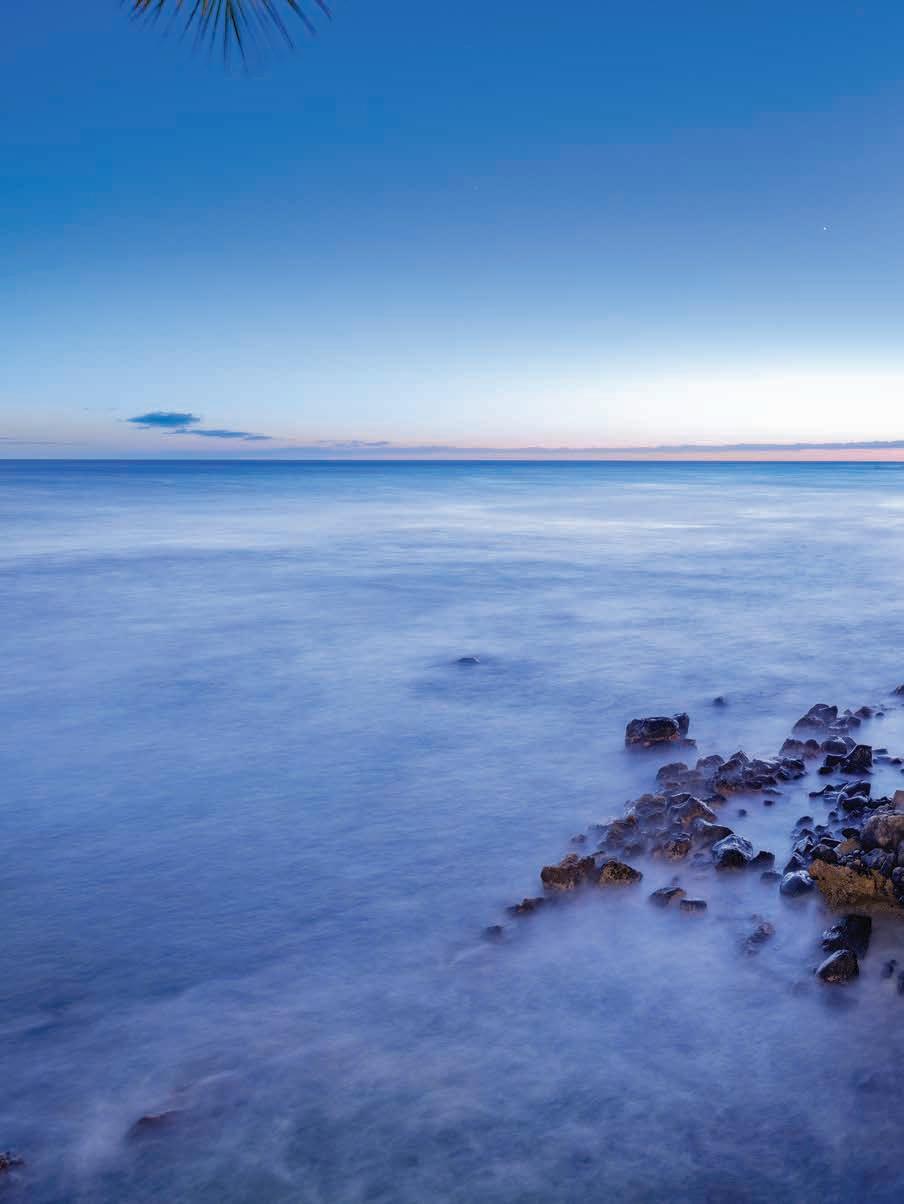
Near the Doris Duke estate known as Shangri La and fronting one of the south shore’s best surf breaks, this three-level home is built on a lava rock promontory, offering ocean views from the terraces on three sides.
104 O‘AHU / COLLECTION
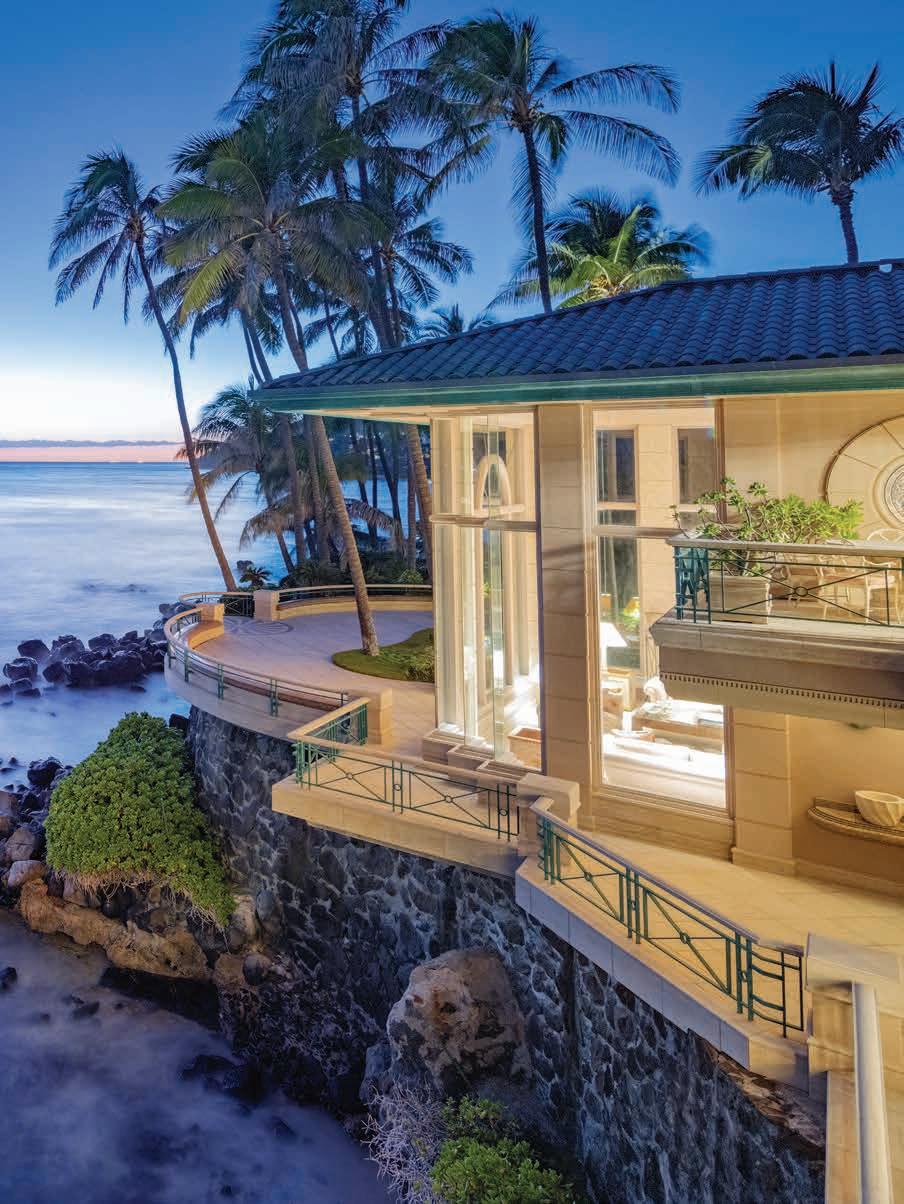
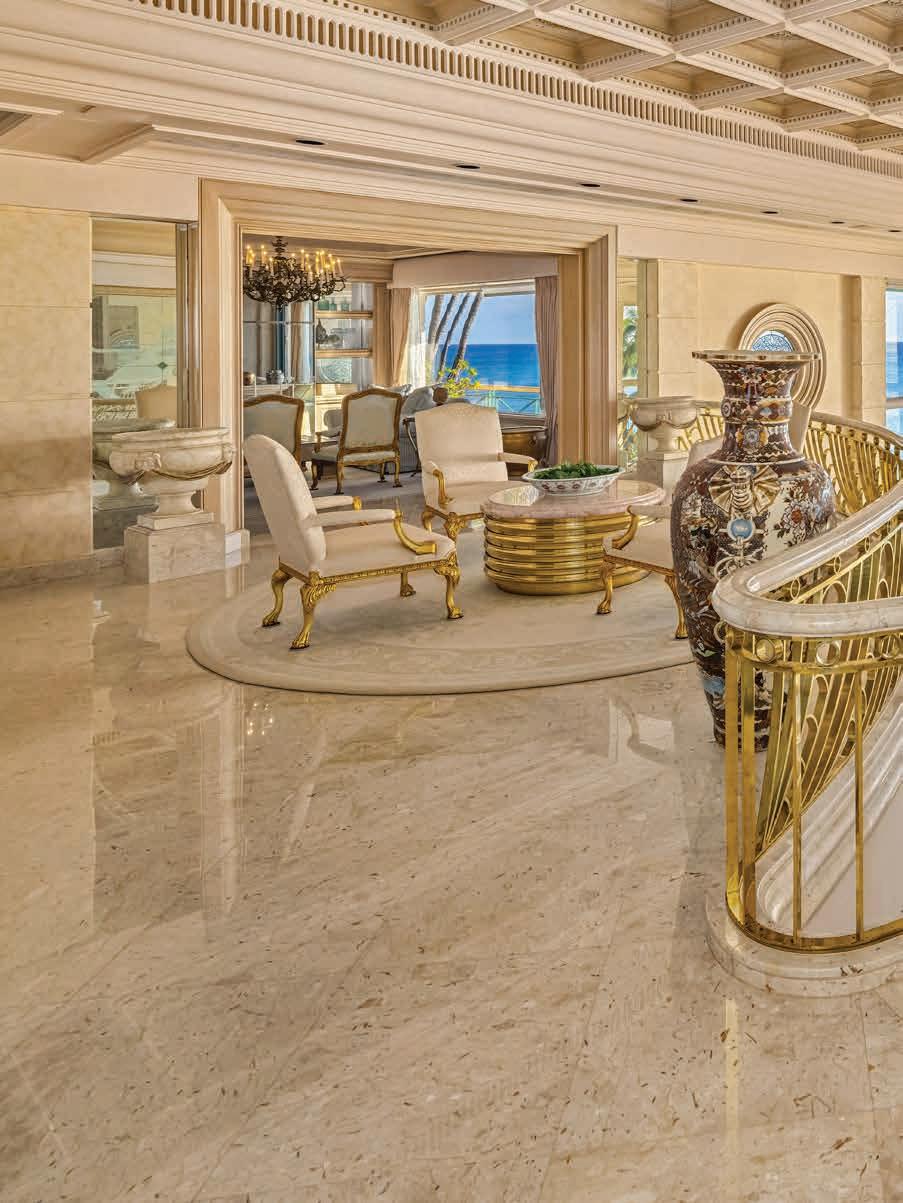
Nestled within a sprawling oasis of landscaped gardens, charming ponds, lush lawns, and two private pools accented by grottos and waterfalls, Villa Kaiko‘o is a world apart from its neighboring south shore attractions.
With 339 feet of coastline at its doorstep, the home combines European grandeur and island indulgence, with no shortage of elegant spaces to relax, entertain, dine, and gather.
106
O‘AHU / COLLECTION

$5.95M | Listed by Noel Shaw
Modern and Minimalist
This unit at the coveted Park Lane residences marries the intimate feel of a single-family home with the convenience of a condominium—all with a meticulously crafted interior, designer furnishings, and views overlooking Ala Moana Beach Park and the ocean beyond. It’s also a gourmand’s dream, equipped with Wolf appliances in the kitchen and grill on the lanai.

108
O‘AHU / COLLECTION
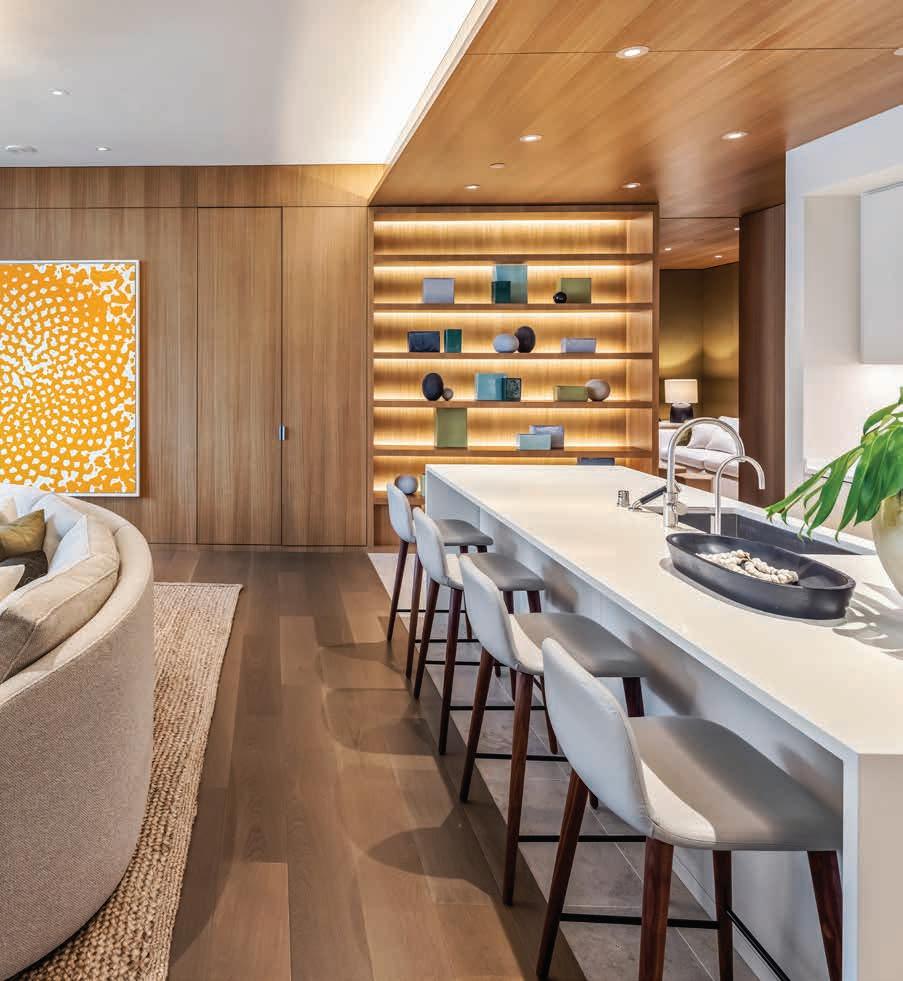
109

Ossipoff
on the Beach
This single-level Hawaiian Modern home designed by legendary Hawai‘i architect Vladimir Ossipoff takes full advantage of its location on Kahala Avenue. The living room frames the ocean and opens to lanais on both sides, allowing sea breezes and natural light to flow through.
110
O‘AHU / COLLECTION
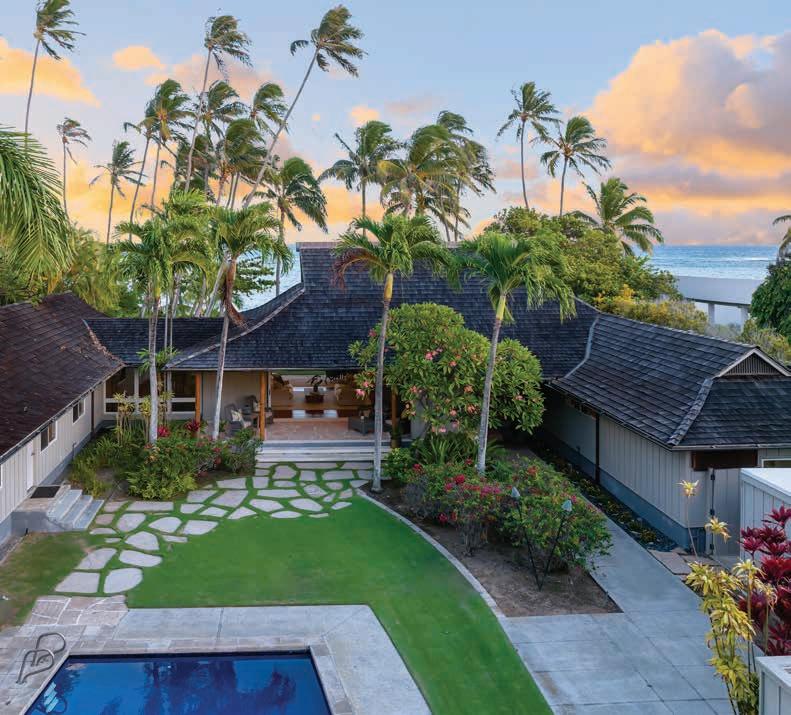
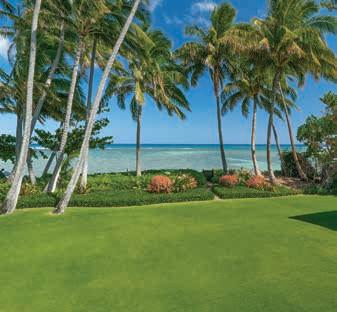 $18.5M | Listed by Neal Norman and Julianna Garris
$18.5M | Listed by Neal Norman and Julianna Garris



For the Maximalist
With influences ranging from Shakespearean fantasies to the travels of Napoleon Bonaparte, this fantastical home in Kahala is a wonderland of marble, granite, and whimsy, with a rococo ceiling, spiral staircase, and elaborate décor and finishes.
$7.6M | Listed by Julianna Garris
113
O‘AHU / COLLECTION
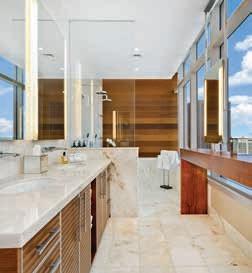

City Living, Ocean Views
This One Ala Moana grand penthouse offers the best of Honolulu’s urban living, lofted above the gleaming south shore in the heart of Honolulu’s vibrant dining and shopping destinations. Features floor-to-ceiling glass walls affording mauka and makai views and an exclusive 1,900+ sq ft rooftop terrace.
114
O‘AHU / COLLECTION

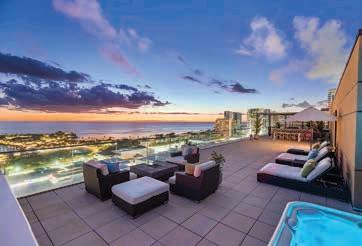
 $7.88M | Listed by Julianna Garris
$7.88M | Listed by Julianna Garris
An Expansive Coastal Estate in Hawai‘i’s Most
Exclusive Community

A modern-day tropical palace with 19 rooms and spaces, Honu Estate on Hawai‘i Island’s captivating Kona Coast melds opulent craftsmanship with the outdoors, offering areas to both gather and seclude.
116 HAWAI‘I / COLLECTION

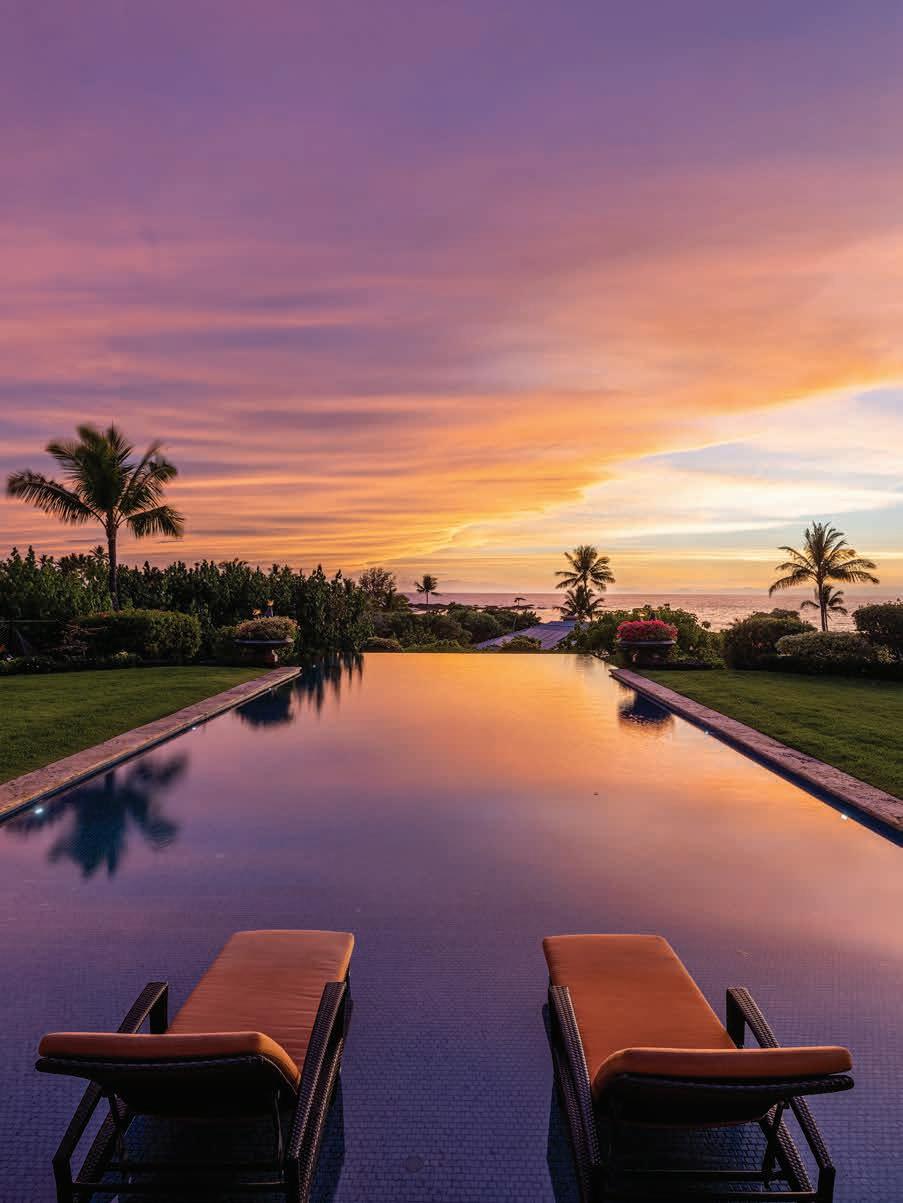
118 HAWAI‘I / COLLECTION

Among the spaces for entertainment and wellness: a tranquil front courtyard, cinema room, live music room, saline pool, yoga room, private meditation garden, and bedrooms that open to the sounds of the ocean.
IMAGES COURTESY OF CARRIE NICHOLSON
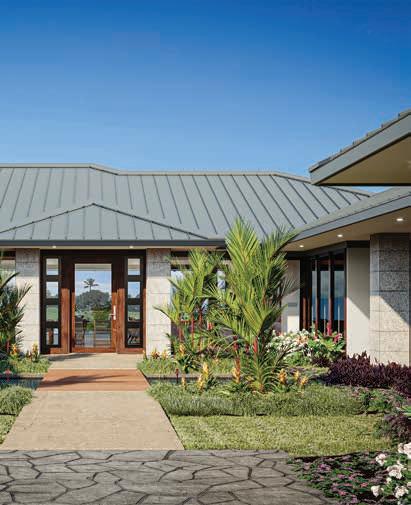
Rockefeller Was Here
When Laurance S. Rockefeller spotted Kauna‘oa Bay, he decided to build near its shores Hawai‘i Island’s first resort—Mauna Kea Resort. In 1960, he made plans for an open-air design that would reflect the tranquil setting. Today, this new residence within the resort’s private Kauna‘oa community calls to mind the same principles of indoor and outdoor living in the environs that first inspired Rockefeller.
120
HAWAI‘I / COLLECTION

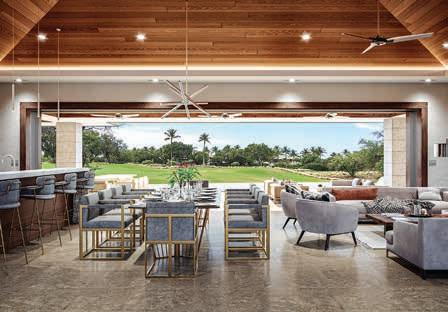 $7.88M | Listed by James Allison
$7.88M | Listed by James Allison
$16.9M |
Listed by Steve Hurwitz
Retreat to Hawi
Combine three parcels in northern Kohala with views from Mauna Loa to Hana to create a personal hideout or agricultural retreat, complete with a citrus orchard and rolling pastures and ranchlands.
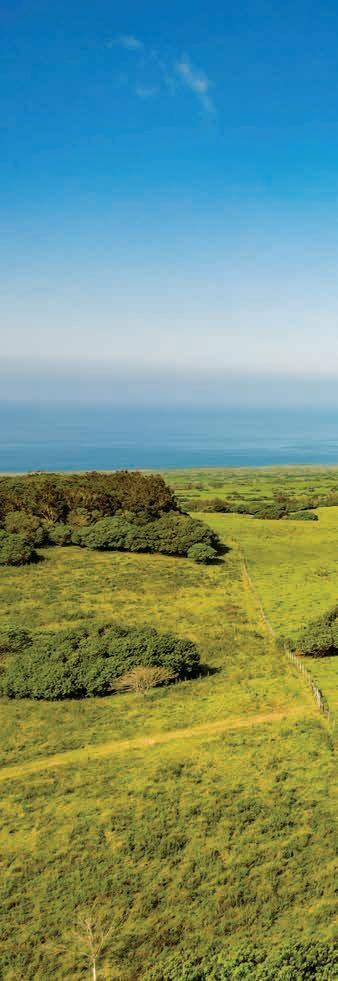
122
HAWAI‘I / COLLECTION

123
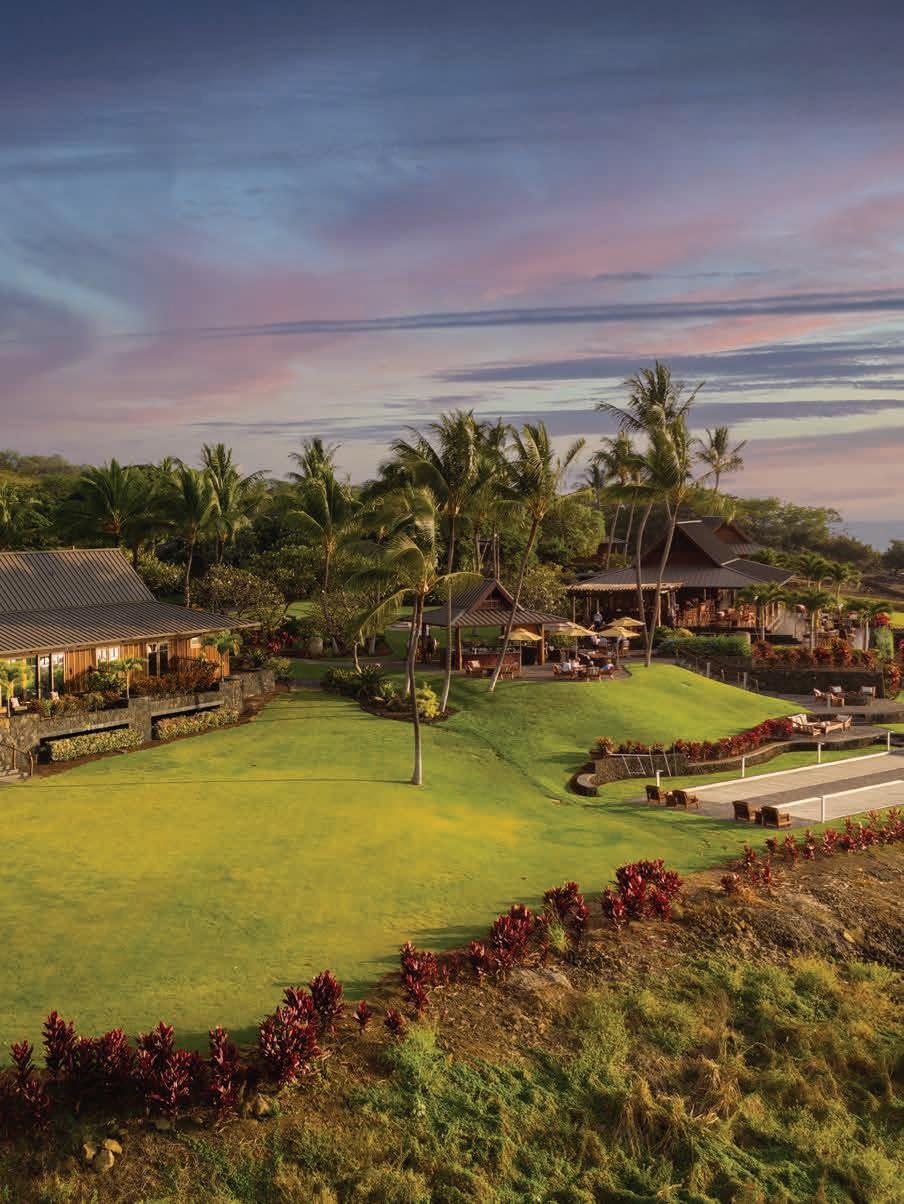

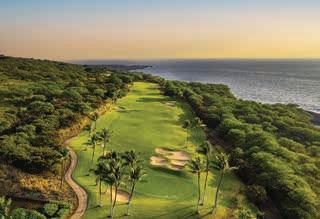
Make Hōkūli‘a Home
Front-row parcels perched above the ocean on the south Kona Coast offer access to world- class amenities and outdoor recreation areas, including a Jack Nicklaus signature golf course, hiking trails through a shoreline historic park, and a canoe landing for kayaking, standup paddleboarding, snorkeling, diving, and fishing adventures in Kona’s clear waters.
$4.2M–7.5M | Listed by Carrie Nicholson
125
/ COLLECTION
HAWAI‘I


Home of the Water Lilies
Along the fifth fairway of Mauna Kea Golf Course, this Oriental-inflected property with intricate woodwork and sprawling indooroutdoor living spaces features a host of recent renovations. Two elegant stairways lead from the second floor to a lily pad-shaped pool and unobstructed views.
126
HAWAI‘I / COLLECTION
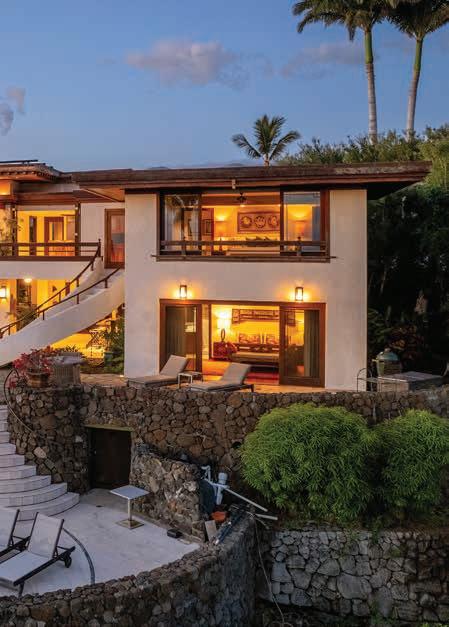
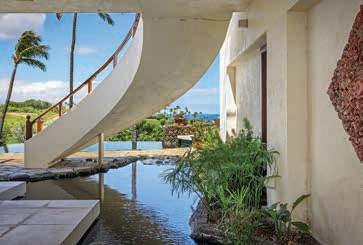
 $7.995M | Listed by Steve Hurwitz
$7.995M | Listed by Steve Hurwitz
$9.5M |
by Josh Jerman and Tim Stice
A Sublime Setting
Once home to pineapple fields, this nearly 76acre lot atop a 130-foot bluff in Ha‘iku overlooks Maui’s sublime north shore. Nearby, Hawai‘i’s fiercest wave, Pe‘ahi, entices daredevil surfers while Pe‘ahi Farms at Opana Point offers an escape to tranquility, whether in the form of farmland, horse stables, or views of Moloka‘i and Haleakala.
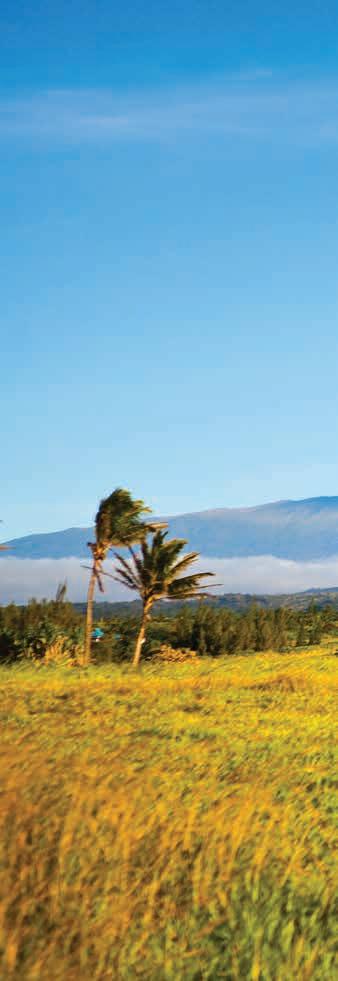
128
Listed
MAUI / COLLECTION

129

Convenient Seclusion
This is the rare Hawai‘i property that offers a sense of isolation—the residence is built on three acres in Makena, with ocean views all the way to the West Maui mountains— despite its proximity to some of the island’s best amenities, including food and dining destinations such as The Birdcage, Hotel Wailea’s sophisticated lobby bar, and Lineage, with its playful, modern Asian offerings.
130
MAUI / COLLECTION


131
$21M | Listed by Dave Richardson



Italian Villa Meets
Maui Beach House
At the end of a narrow country road in the town of Pa‘ia is this home that’s part Italian villa and part Maui beach house. The lawn transitions into the sand of tucked-away Ku‘au Cove, and just up the beach is one of the island’s most beloved restaurants, Mama’s Fish House, dating back to 1973.
$12M | Listed by Josh Jerman
133 MAUI / COLLECTION
Serene Minimalism Steps from Anini Beach

This modern, minimalist beachfront estate features two licensed vacation rental homes fronting a white sand beach, which overlooks one of the largest living coral reefs in Hawai‘i. Custom millwork in light wood and walls of glass let the ocean vistas take center stage.
Spanning a secluded acre of beachfront along a lively cove renowned for its sheltered waters, the property’s neighboring bluegreen depths offer ideal conditions for snorkeling, shore fishing, paddleboarding, and windsurfing.
134 KAUA‘I / COLLECTION
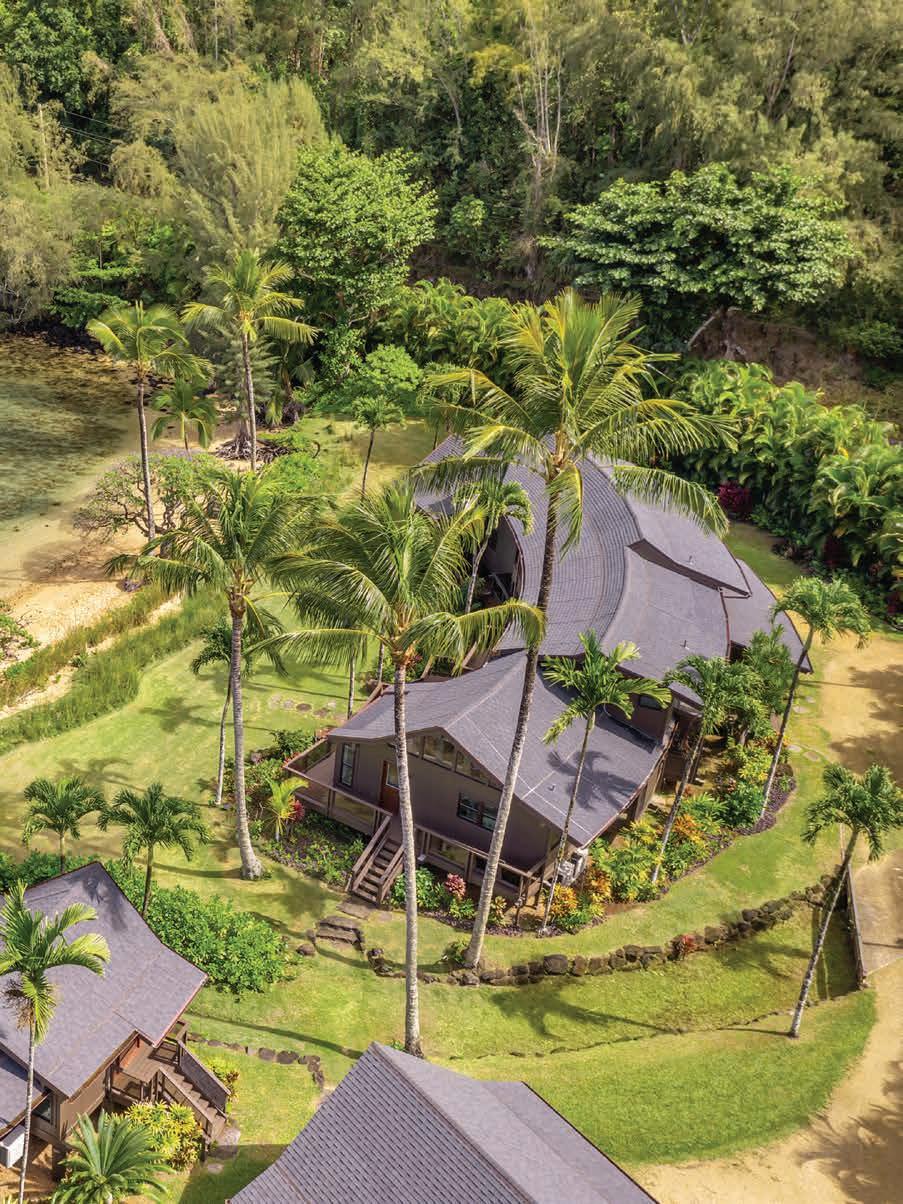
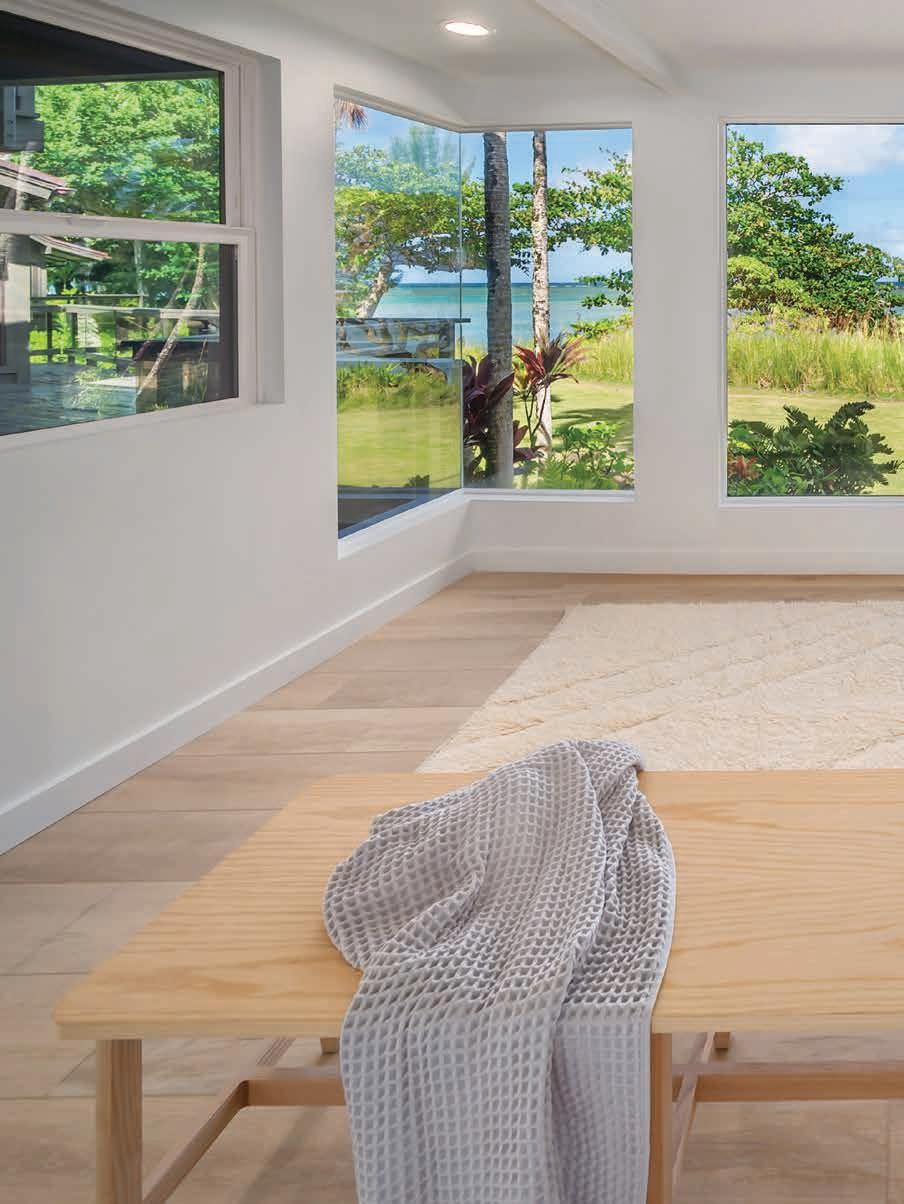
136 KAUA‘I / COLLECTION
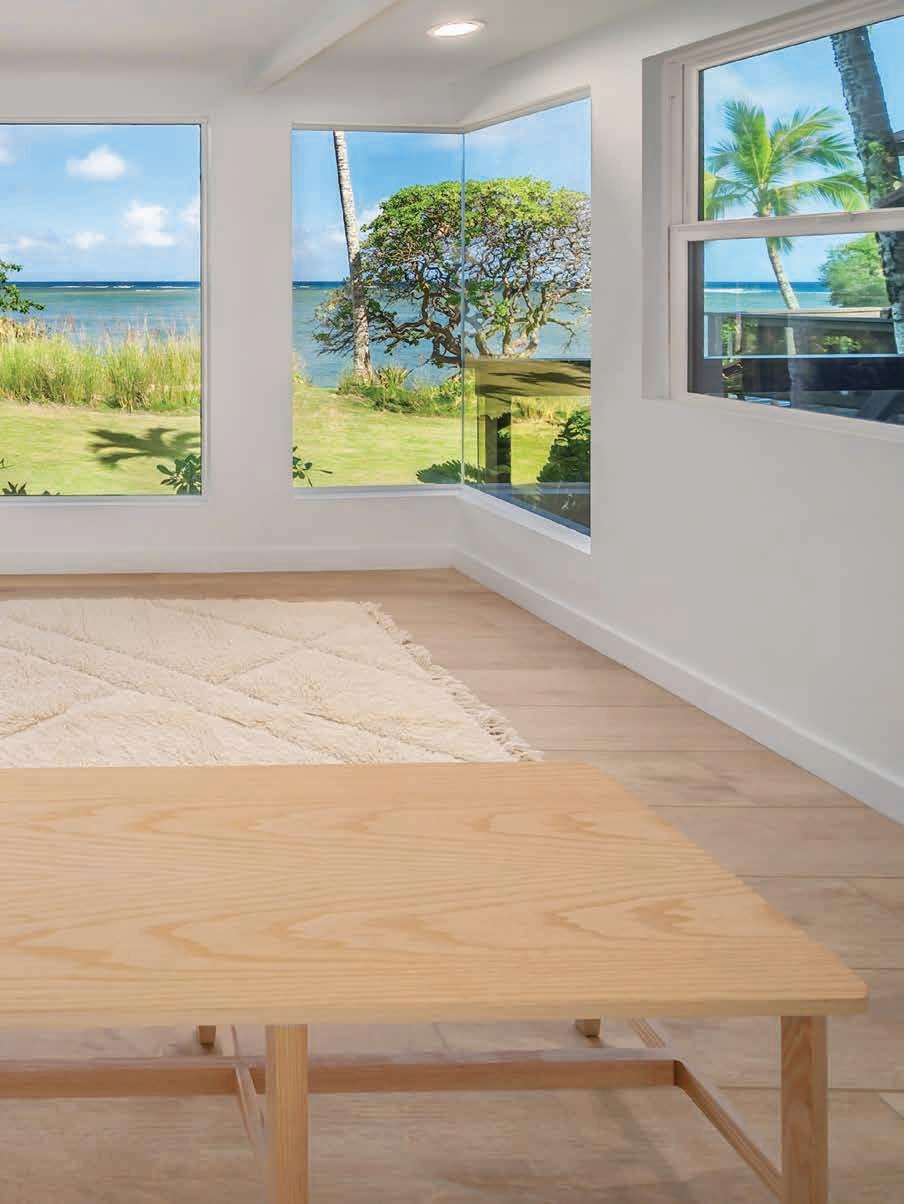
Even indoors, the waves are never far—the main home and detached guest cottage are filled with the soothing sight and sound of the ocean beyond.
$12.5M |
The Butterfly House
The first newly constructed beachfront home to be offered on Kaua‘i’s north shore in over two decades, this contemporary residence in Hanalei takes cues from mid-century modern architecture, with a soaring butterfly roof framing its mauka and makai views: the reefs of Kepuhi Beach in front and the Wainiha ridgeline in back.

138
Listed by Ben Welborn and Tiffany Spencer
KAUA‘I / COLLECTION
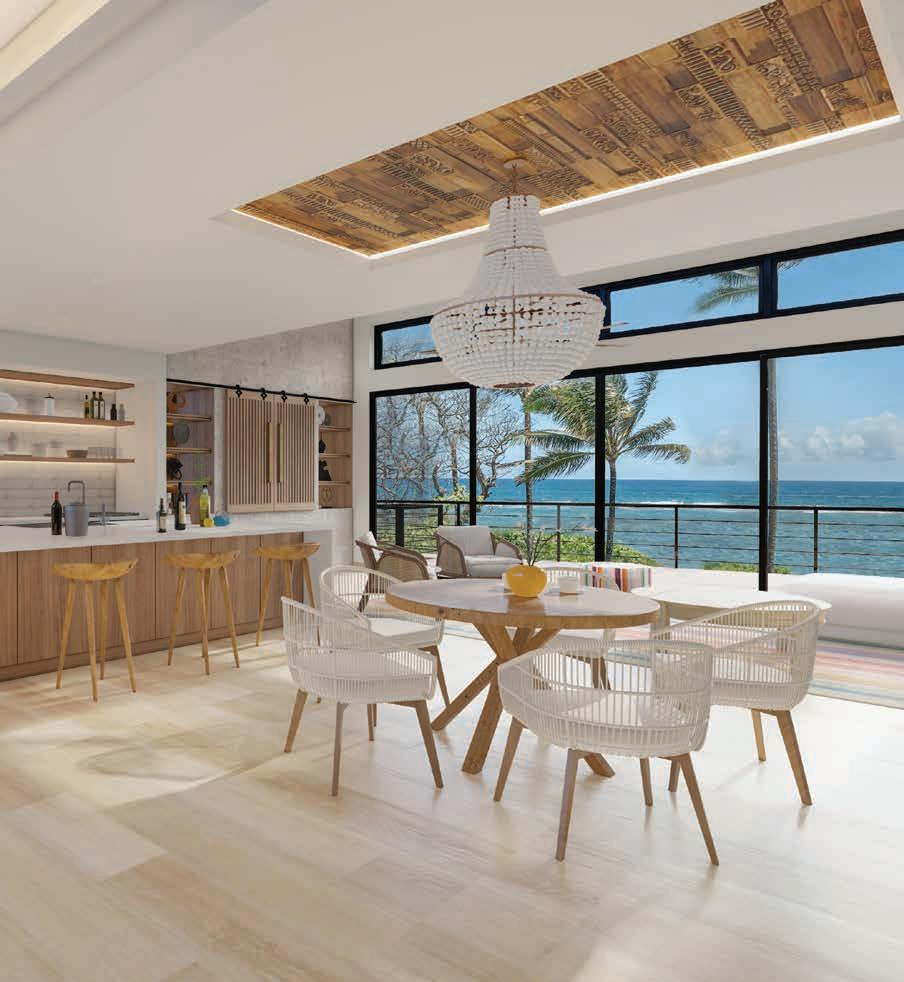
139
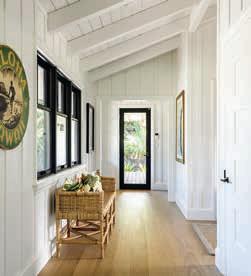

Bungalow by the Bay
Vaulted ceilings and disappearing glass doors invite the outdoors in at this Hanalei home designed by notable California architect Kevin A. Clark. An alfresco garden shower refreshes after a morning strolling Hanalei town or swimming in the ocean, located just steps from the property.
140
KAUA‘I / COLLECTION

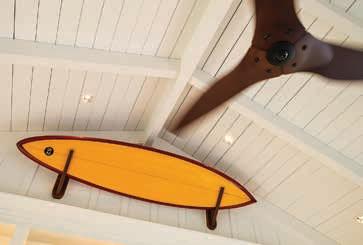
 $22M | Listed by Neal Norman
$22M | Listed by Neal Norman

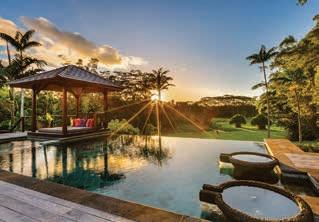
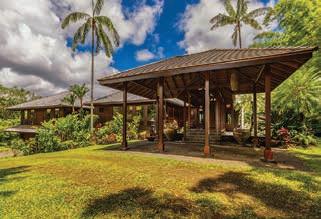
North Shore, Bali Style
Nestled below Mount Namahana in a lush, secluded enclave in K Ī lauea, this expansive 3.5-acre estate embraces its surroundings with extensive covered outdoor living areas cooled by trade winds and separate bedroom suites connected by open breezeways.
|
$7.4M
Listed by Neal Norman
143 KAUA‘I / COLLECTION
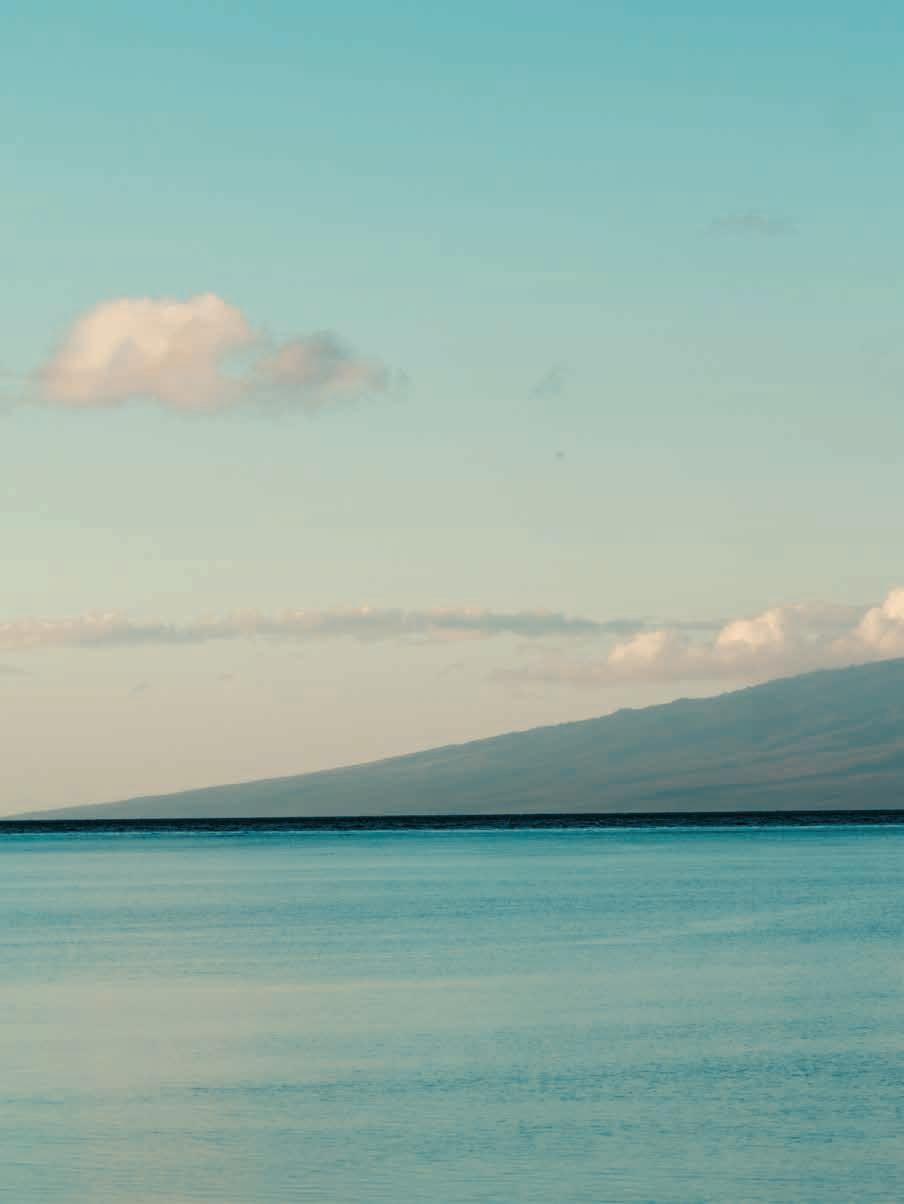



































 IMAGES BY BLAKE ABES
IMAGES BY BLAKE ABES












































































































 $18.5M | Listed by Neal Norman and Julianna Garris
$18.5M | Listed by Neal Norman and Julianna Garris







 $7.88M | Listed by Julianna Garris
$7.88M | Listed by Julianna Garris






 $7.88M | Listed by James Allison
$7.88M | Listed by James Allison









 $7.995M | Listed by Steve Hurwitz
$7.995M | Listed by Steve Hurwitz


















 $22M | Listed by Neal Norman
$22M | Listed by Neal Norman



